3DNews has moved away from regular testing of SATA SSDs for quite some time, focusing on PCIe drives. But this did not happen on purpose, but under the influence of market trends. SSD manufacturers themselves have gradually shifted the focus to more promising and faster NVMe models, which are clearly of greater interest to the advanced part of the computing community. In addition, NVMe SSDs are more interesting for manufacturers themselves. They are more expensive and more profitable to produce, and in addition, NVMe drives allow manufacturers to clearly demonstrate the technological potential of the device, without limiting the bandwidth of the external interface.
However, all of this does not mean at all that the SATA SSD market is dead. SATA drives are still comparable to NVMe models in terms of mass consumer attention, and most importantly, SATA SSD sales are not yet on a downward trajectory. We were convinced that our readers also have significant interest in what is happening on the SATA SSD market when we tested the Samsung 870 EVO – an article about it caused a rather lively response. This prompted us to try to pay more attention to drives with a traditional SATA interface, because they may be of interest not only to owners of old systems who want to upgrade. In fact, there are other reasons to opt for a SATA SSD. For example, such drives are not susceptible to overheating, they can have a higher capacity, and in the end, they are simply cheaper, despite the fact that the level of performance they offer can suit many users of systems, not only entry-level, but also mid-level.
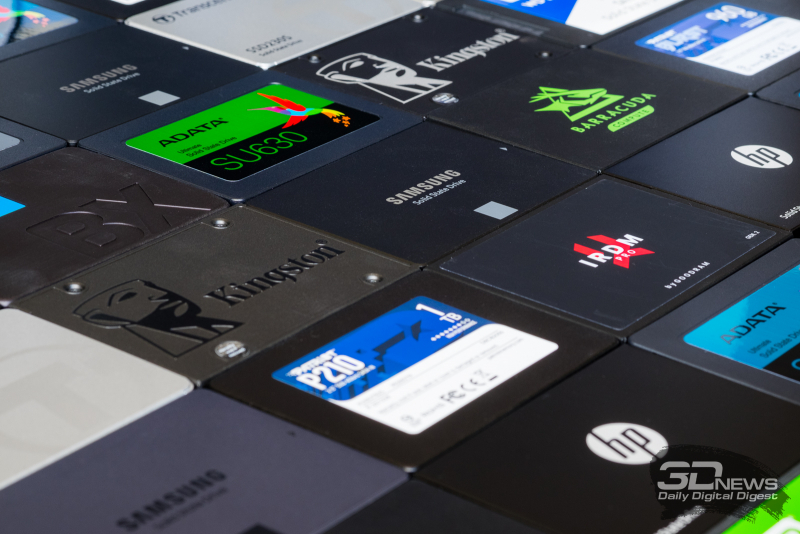
However, there is a significant problem with SATA SSD: progress in this area has almost completely stopped. New drives with this interface rarely appear, and the aforementioned Samsung 870 EVO is an isolated case when the manufacturer has made some real improvements to a productive SATA drive. Basically, the few new SATA models that have appeared recently are cheaper and simplified solutions in which manufacturers tried to save money in every possible way: by using the simplest controllers, switching to a bufferless design and using QLC memory. Moreover, a similar evolution quietly occurs with well-known and popular SSD models: a noticeable share of drives that pleased us in 2017-2018, if not left the market, then imperceptibly moved to other controllers and other memory, which in almost all cases led to a deterioration in consumer characteristics.
In other words, the SATA SSD market has come to a rather confusing situation where there are many familiar names on it, but underneath they offer something completely different from what it used to be. Plus, the new models that have appeared on sale in most cases do not surpass the old SSDs in consumer characteristics and can be interesting only when the first place is to save money. In such conditions, the only logical option for studying SATA SSD was to turn to the genre of large comparative reviews, which compare the maximum possible number of actual drives taken from retail, selected in accordance with certain criteria. This is exactly the kind of comparative testing we conducted this time as well.
Today we will talk about the SATA SSDs presented on the shelves of stores in a 2,5-inch form factor with a capacity of 1 TB. For the tests, we tried to select the most popular and popular models from leading manufacturers. As a result, 25 different products took part in the study. Moreover, it should be emphasized that the testing was carried out simultaneously. That is, all performance indicators were taken on an unchanged test system with the most recent version of the Windows 10 operating system with the latest drivers and the latest firmware versions. And what’s more, all the drives in the comparison were taken from the retail sale just before the tests, that is, the results obtained characterize exactly those SSD versions that you can actually buy at the present time.
⇡ # What’s wrong with modern SATA SSDs
As NVMe drives become more widespread, their SATA siblings are gradually fading into the background. Most SSD manufacturers have changed their attitude towards SATA products and began to consider them as low-end offers – budget consumer goods, where the main competitive advantage is not reliability or performance, but a low price. And the spread of this paradigm has led to the fact that the SATA SSD market has changed, and not for the better for users.
Most manufacturers try to economize in one way or another when releasing SATA SSDs, and these savings have very specific consequences. No additional accessories have been included with a SATA SSD for a long time; often these drives are not sold in boxes, but in blisters; the enclosures of the SSDs themselves have also changed – now they are more often made of plastic, rather than aluminum, and assembled on latches. But much worse is that the savings also apply to the hardware component. If you look at what components modern SATA SSDs are made of, it turns out that in a significant part of them, bufferless controllers with a truncated number of channels are installed, four-bit QLC memory, and often both at the same time.
And this would not be a big problem if the dominance of such cheaper SSD configurations were known in advance. But many manufacturers of the second and third tier are very secretive. In fact, being engaged in the “screwdriver” assembly, they do not declare a specific element base of the supplied products, leaving themselves a wide scope for manipulation. And now this space has become very actively used by them. There are cases when, in a popular drive model that has been on the market for several years, the established hardware filling without any warning is replaced by cheaper and worse in terms of characteristics – not one or two, this is a common practice.

As a result, the choice of SATA SSD has turned into a kind of roulette wheel – the name SSD often does not mean anything at all, and the user will only learn about the real characteristics of the purchased SSD after purchasing it. That is why summary testing such as this is important: in it we will check what specific hardware platforms live in those solid-state drives that are on store shelves today, and how much they differ from the same drives, but released a year or a couple of years ago. …
However, even such massive and detailed tests are not a panacea. The configuration of many SATA SSDs changes chaotically and unpredictably, so the information presented below regarding some models can quickly lose its relevance.
There is only one way to guarantee insurance against “surprises” in the form of buffer-free drives on QLC 3D NAND – by purchasing an SSD, for which the hardware is clearly and specifically described in the specifications. There are few such models, but all Samsung products, the technical details of which are documented in more detail, as well as the flagship devices Kingston and GoodRAM, are good examples. Below, when describing the drives that took part in testing, we will pay special attention to how fully a particular manufacturer discloses the hardware characteristics of their products.
In addition, it should be noted that there is another small group of conscientious manufacturers who, although they do not provide all the details about their devices, still adhere to SSD configurations that have been unchanged for several years. These include Western Digital, Seagate and Transcend, and in the absence of dirty tricks from the products of these companies, too, can be trusted to a certain extent.
⇡ # ADATA Ultimate SU800
ADATA Ultimate SU800 can be called an ancient drive by the standards of the computer market, because it appeared on the market back in 2016. It was then an innovative model based on the SMI SM2258 controller and 800D TLC memory, and oddly enough, not much has changed over the past five years. The drives called Ultimate SU3 still use both SMI and TLC XNUMXD NAND controllers, and what is especially nice, the manufacturer does not resort to any attempts to reduce the cost of the product to the detriment of consumer qualities.
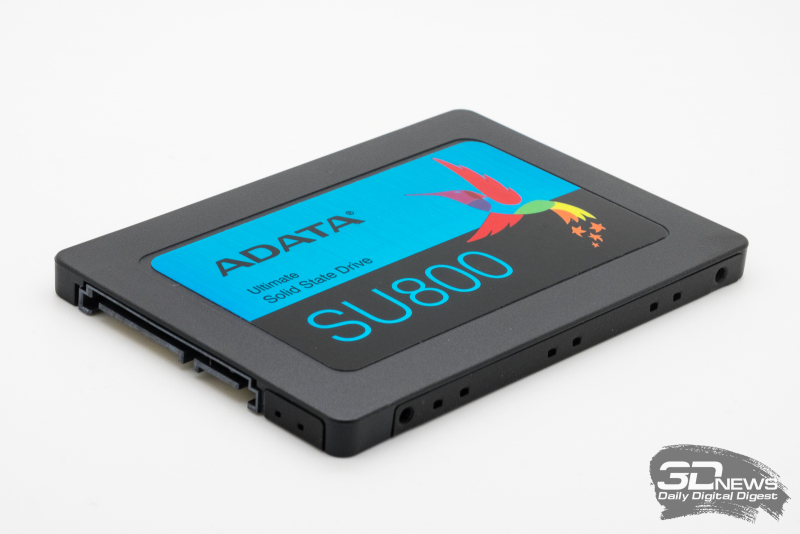
The Ultimate SU800 specifications on the manufacturer’s website do not indicate a specific type of controller used, but they outline the configuration in general terms, clearly stating that there is a DRAM buffer in the drive.
| ADATA ULTIMATE SU800 | Stated | Actually |
|---|---|---|
| Capacity | 1 TB | 954 GiB |
| Controller | SMI | SMI SM2258 |
| DRAM | There is | 1024 MB DDR3 SDRAM |
| NAND | TLC 3D NAND | Samsung 64-layer 256-Gbps TLC 3D V-NAND |
In fact, the modern Ultimate SU800 seems to be a pretty powerful option. There is also a full-fledged four-channel SM2258 controller, and DRAM for buffering requests to the address translation table, and flash memory with a capacity of 256 Gbit crystals, which gives a high degree of parallelism of its array. Separately, it should be noted the use of three-dimensional flash memory made by Samsung, albeit a rather old fourth generation. That said, it’s still fast by today’s standards, and paired with SMI controllers to get better performance than the Micron’s 64-layer memory. This makes the current Ultimate SU800 look even more interesting than the original version of this drive.

Numerical specifications ADATA Ultimate SU800 promise a good level of performance, a relatively high resource, but only a three-year warranty.
| ADATA Ultimate SU800 1TB | |
|---|---|
| Linear read speed | 550 MB / s |
| Linear recording speed | 500 MB / s |
| Random read speed | 80 IOPS |
| Random write speed | 80 IOPS |
| Recording resource | 800 TB |
| Mean time between failures | 2 million h |
| Warranty | 3 years |
In the synthetic test CrystalDiskMark, run on the AMD platform, however, the results are slightly lower than those stated. The peak sequential write speed is only 485 MB / s, and the measured small-block read and write speeds (with the maximum request queue) are 62 and 52 thousand IOPS.
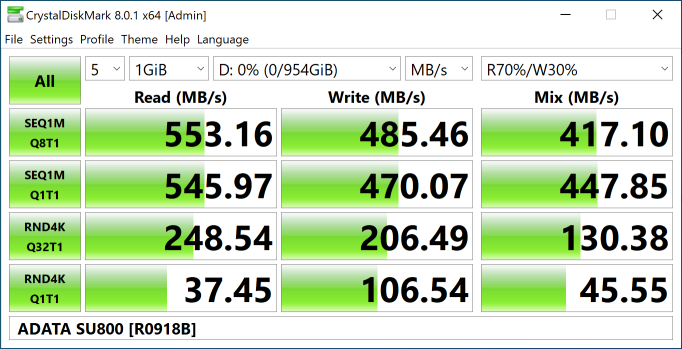
However, in comparison with what other drives give in such measurements, this is a completely normal result. However, it should be borne in mind that in order to achieve it, the SMI SM2258 controller operates with the entire set of acceleration technologies based on dynamic SLC caching, both for writing and for reading. For the user, this mainly means that files that have not just been saved to the drive are read about 25% slower than fresh ones.
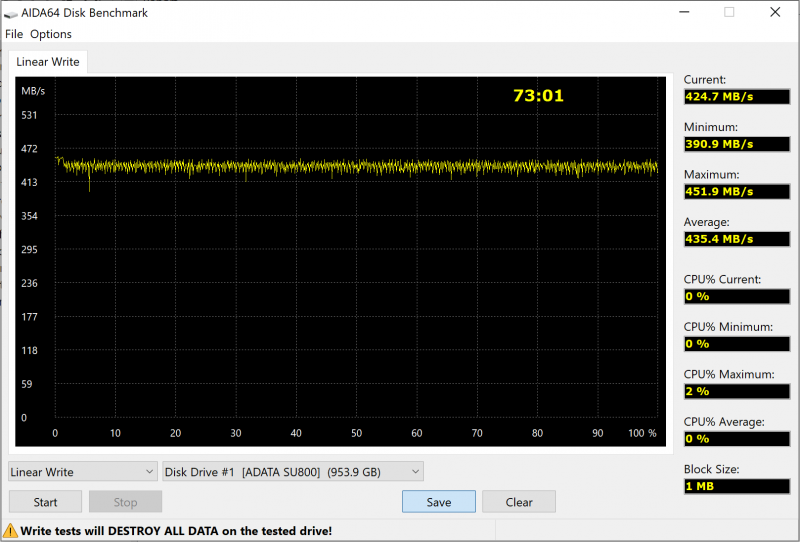
But with a sequential linear write, the effect of the SLC cache is not visible at all, since the flash memory array has sufficient bandwidth in its usual three-bit mode. Thanks to this, the Ultimate SU800 terabyte can be recorded in 73 minutes, which is close to the best for a SATA SSD.
⇡ # ADATA Ultimate SU750
ADATA Ultimate SU750 is a relatively recent model of ADATA SATA drive, the first mention of it dates back to 2019. It was originally released as a bufferless SSD based on TLC 3D NAND and a Realtek RTS5733DMQ controller, and it remains so to this day. Despite the high model number, this is clearly a budget model, but one where it has not yet come to the use of QLC 3D NAND.
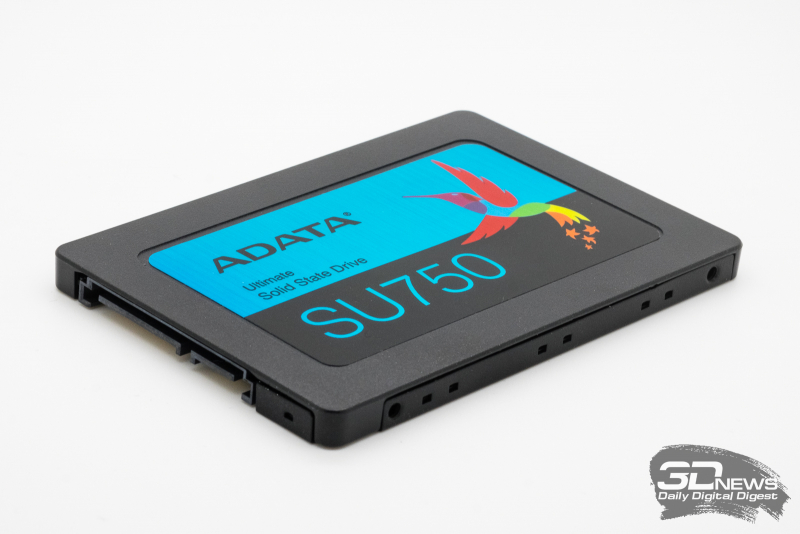
However, in the official specification Ultimate SU750 its hardware filling is described as vaguely as possible. Therefore, if at one fine moment there is a four-bit memory in it, it will not contradict the declared characteristics. In other words, the SU750 can potentially be transformed by the manufacturer into the most affordable solution.
| ADATA ULTIMATE SU750 | Stated | Actually |
|---|---|---|
| Capacity | 1 TB | 954 GiB |
| Controller | — | Realtek RTS5733DMQ |
| DRAM | — | No |
| NAND | 3D NAND | Sandisk 96-layer 512Gb TLC 3D NAND |
In the version of the drive that came to us for tests, a Sandisk TLC BiSC4 was used as a flash memory. Previously, Micron TLC memory was more common in such drives, but by and large this is not so important. It is not the bandwidth of the flash memory array that hinders the performance of this SSD, but the Realtek RTS5733DMQ controller itself. Firstly, it uses only two channels to form a flash memory array, and secondly, it does not provide a DRAM interface, which means that there is no full buffering for small-block operations.
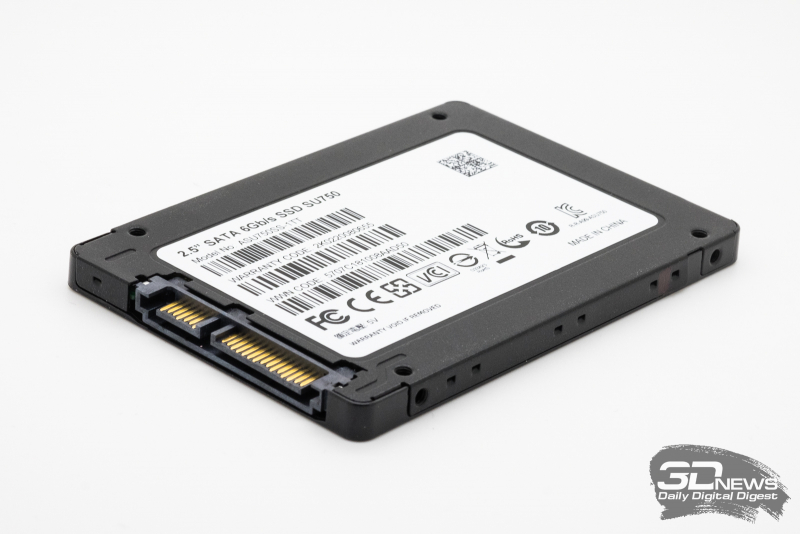
Against this background, the performance figures of the SU750 announced on the ADATA website do not seem very real.
| ADATA Ultimate SU750 1TB | |
|---|---|
| Linear read speed | 550 MB / s |
| Linear recording speed | 500 MB / s |
| Random read speed | 65 IOPS |
| Random write speed | 75 IOPS |
| Recording resource | 800 TB |
| Mean time between failures | 2 million h |
| Warranty | 3 years |
Nevertheless, when measuring practical characteristics using the CrystalDiskMark benchmark, the results are quite good. It seems that the Ultimate SU750 is only slightly inferior in performance to the Ultimate SU800. The performance of this model is especially advantageous for mixed operations.
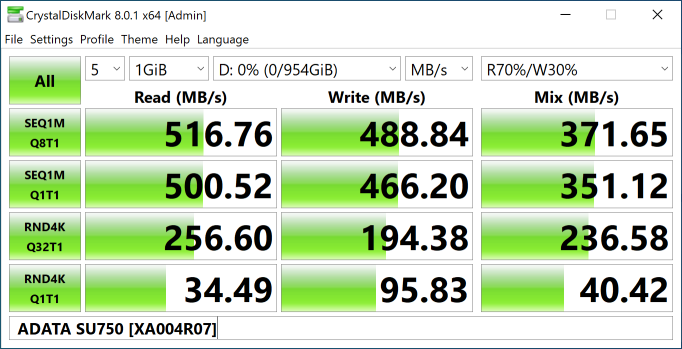
But all this is a deceptive impression created by the presence of a small amount of buffer memory in the controller itself and the active use of dynamic SLC caching for reads and writes. In real life, when calls are made to data distributed over the drive, which were recorded on it earlier, the speeds turn out to be one and a half to two times lower than that of the SU800, in whose architecture there are no compromises.
The Ultimate SU750 Flash Array’s real-world capabilities can be gained from a sequential write test across the entire SSD capacity. It will take 4,5 times more time to fill this drive with data completely than in the case of the SU800.
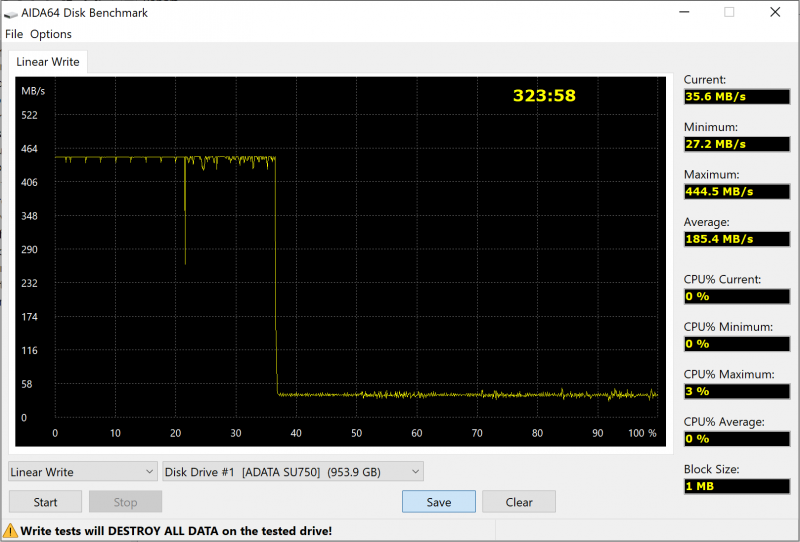
Thus, among the positive qualities of the Ultimate SU750, it is worth noting at all performance, but good reliability indicators, according to which this SSD looks better than average. Which, however, is logical – in this case, ADATA did not save on memory.
⇡ # ADATA Ultimate SU720
The variety of different SATA SSD models produced by ADATA is sometimes puzzling. The point is that some models are very similar to each other, and a higher model number does not always mean better performance. However, in the case of the Ultimate SU720, everything is quite simple. Unlike its older counterparts, this drive uses QLC 3D NAND. At least this is the situation at the moment.
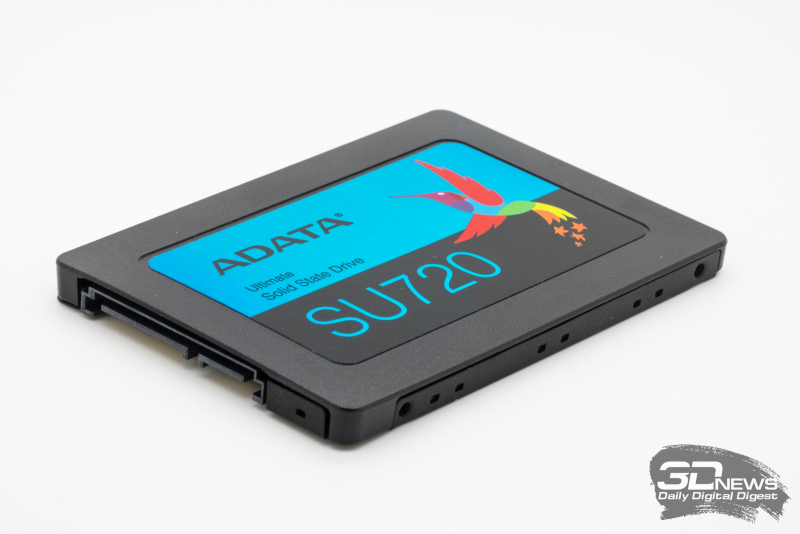
More specifically, we are talking about a 96-layer QLC 3D NAND from Micron, which is controlled by the Maxiotek MAS0902 controller. We are already accustomed to the fact that ADATA prefers to use Realtek controllers, which are rarely found in products from other manufacturers, but the Ultimate SU720 is even more exotic. in terms of fillingSSD. Here the Maxio platform is used – the development of the company previously known by the JMicron brand. And this is a pretty good choice, at least the Maxiotek MAS0902 chip outperforms Realtek controllers in power.
| ADATA ULTIMATE SU720 | Stated | Actually |
|---|---|---|
| Capacity | 1 TB | 932 GiB |
| Controller | — | Maxiotek MAS0902 |
| DRAM | — | No |
| NAND | 3D NAND | Micron 96-layer 1024-Gbps QLC 3D NAND |
In the official specification, ADATA does not indicate anything definite about the SU720. This is natural, since the drive has a rather weak hardware configuration, and there is absolutely nothing to be proud of. Here QLC memory is used, and there is no DRAM buffer. The situation can be saved only by the fact that the Maxiotek MAS0902 controller is a four-channel, and the Micron’s 96-layer memory has good performance on its own. However, the Ultimate SU720 is an entry-level drive anyway.
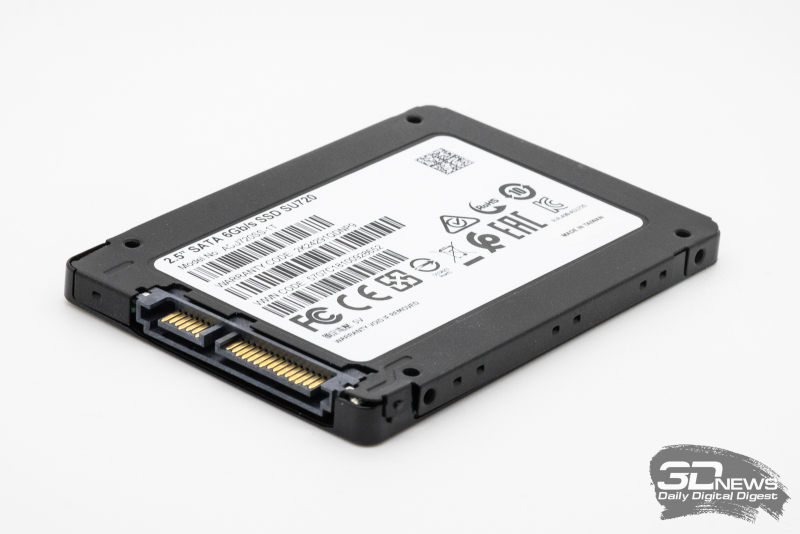
The Ultimate SU720’s poor performance rating is no surprise.
| ADATA Ultimate SU720 1TB | |
|---|---|
| Linear read speed | 520 MB / s |
| Linear recording speed | 450 MB / s |
| Random read speed | 50 IOPS |
| Random write speed | 65 IOPS |
| Recording resource | 200 TB |
| Mean time between failures | 2 million h |
| Warranty | 3 years |
Together with low speeds, a small recording resource is striking. Since the drive uses four-bit memory, the manufacturer guarantees only 200 rewrites of the full capacity of the SSD, that is, the SU720 is proposed to be used very carefully.

Surprisingly, the numbers obtained for the Ultimate SU720 in the synthetic test CrystalDiskMark look very good. But this is entirely due to SLC caching, which works for both writes and reads.
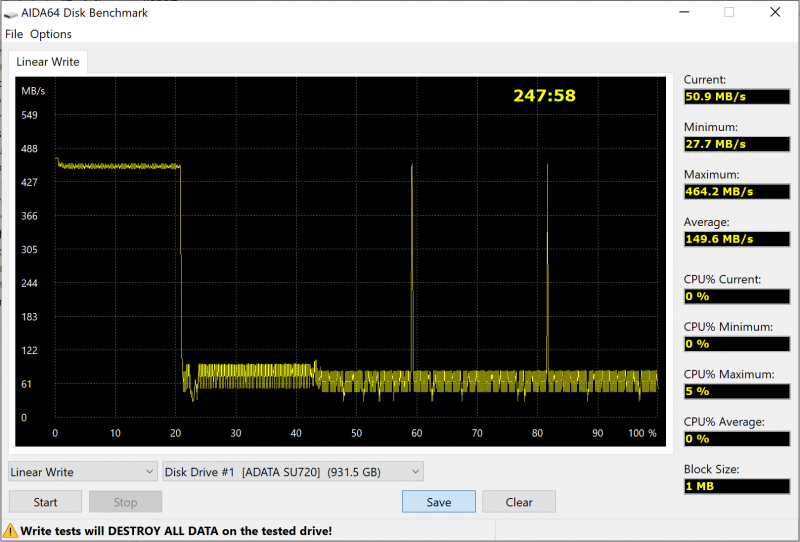
CrystalDiskMark does not show this, but outside of the SLC cache, the linear write speed is in the region of 70-80 MB / s, and the random read speed is about 26 MB / s. This means that in day-to-day operation, the SU720 will be significantly slower than the SU800-class SATA drives. In addition, due to the absence of a DRAM buffer in the design, such a drive is contraindicated in one-step operations with large amounts of data.
However, the four-channel architecture of the controller allows for higher direct write speeds to the flash memory array. In terms of direct write speed in QLC mode, the Ultimate SU720 surpasses some TLC drives, for example, the same Ultimate SU750.
⇡ # ADATA Ultimate SU650
It would seem that the hardware filling of the Ultimate SU720 marked the very bottom for ADATA products. But in the ADATA lineup there are models that formally stand even lower in the hierarchy. For example, Ultimate SU650. But the surprise here is that this is a drive that is actually … better than the SU720. Moreover, it may well aim at internal rivalry with the SU750.
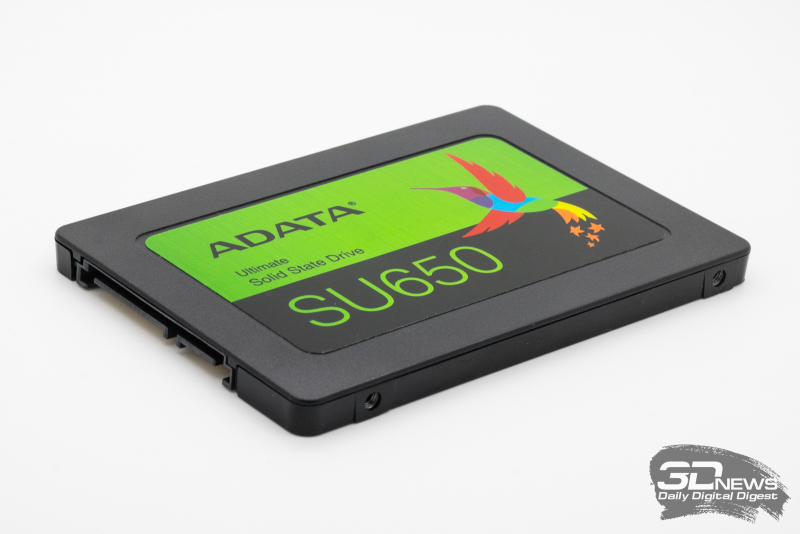
The Ultimate SU650 version that we got for this comparison was based on a bufferless and two-channel RTS5732DLQ controller – the closest relative of the Realtek RTS5733DMQ. At the same time, the drive used 64-layer TLC 3D NAND, manufactured by Samsung. This combination is similar to a variation of the Ultimate SU750 configuration, but keep in mind that there is no specifics in the specifications of either model, and therefore the controller and memory may change at any time.
| ADATA ULTIMATE SU650 | Stated | Actually |
|---|---|---|
| Capacity | 960 GB | 894 GiB |
| Controller | — | Realtek RTS5732DLQ |
| DRAM | — | No |
| NAND | 3D NAND | Samsung 64-layer 512-Gbps TLC 3D V-NAND |
For example, in 2018, when the Ultimate SU650 first appeared on the market, it could be found in the SMI SM2258XT controller and Micron TLC memory. At the same time, the existence of the SU720 model with QLC memory suggests that moving the SU650 to QLC 3D NAND is a matter of time.
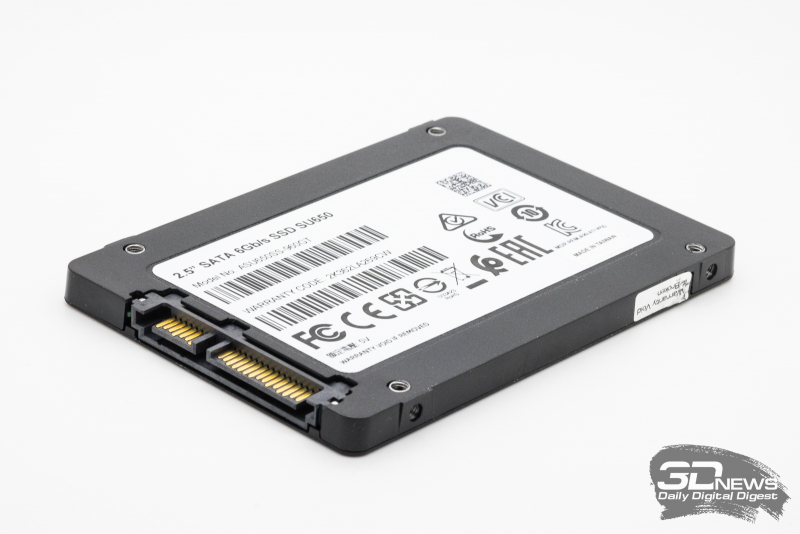
At the same time, rather weak performance characteristics were announced for the Ultimate SU650. If you focus on these numbers, it will have to be recognized as one of the slowest SATA drives in today’s test, although in reality this is not at all the case.
| ADATA Ultimate SU650 960GB | |
|---|---|
| Linear read speed | 520 MB / s |
| Linear recording speed | 450 MB / s |
| Random read speed | 40 IOPS |
| Random write speed | 75 IOPS |
| Recording resource | 560 TB |
| Mean time between failures | 2 million h |
| Warranty | 3 years |
The CrystalDiskMark readings do not look too optimistic. True, if there is complete agreement on linear speeds between the official characteristics and real measurements, then the performance of small-block reading in the test is clearly higher than the value indicated by ADATA itself.
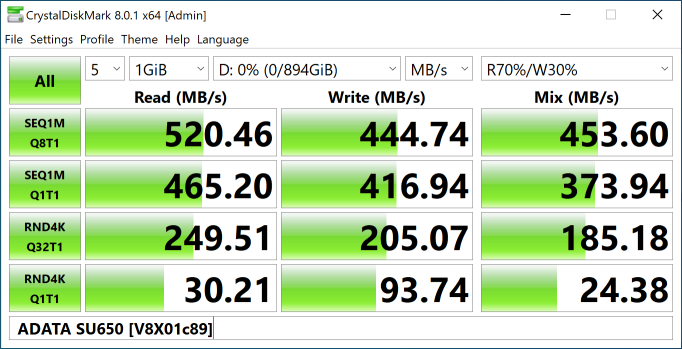
The dynamic SLC caching technology makes a significant contribution to improving the results of the synthetic test. It helps to improve performance when writing and reading small amounts of data. It should be borne in mind that in reality, the reading speed of the Ultimate SU650, built on a bufferless platform, can decrease several times relative to the value obtained in CrystalDiskMark. For example, outside of the SLC cache, the write speed to memory is only 45 MB / s.
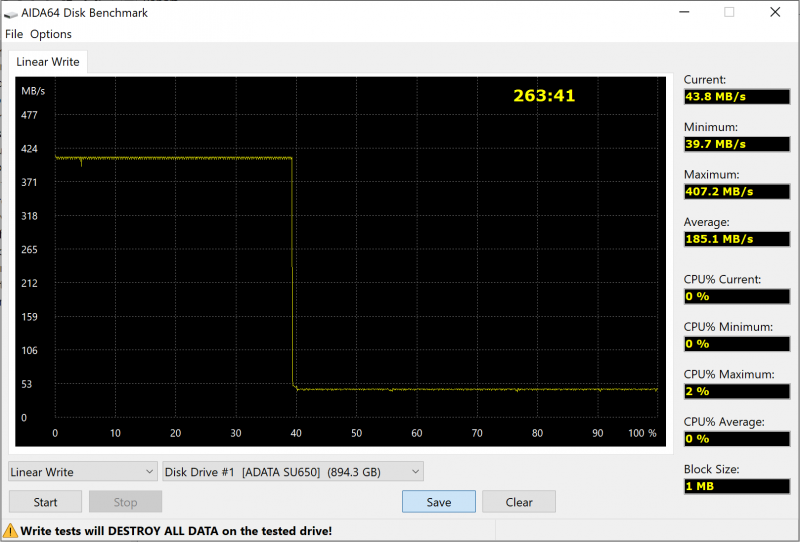
At the same time, it should be mentioned that the Ultimate SU650 has a declared resource that is more typical for drives based on TLC memory. This is another reason why the SU650 seems to be a significantly more interesting model at the moment compared to the SU720.
⇡ # ADATA Ultimate SU630
The youngest ADATA drive is another perfect example of the confusion this company has thrown in its lineup. Ultimate SU630 was introduced in 2018 and immediately positioned itself as the most affordable solution based on four-bit memory. Moreover, the use of QLC 3D NAND in this case was explicitly enshrined in the specification. However, later it turned out that ADATA was ready to rethink its own statements as widely as possible, and the filling of the Ultimate SU630 began to change unpredictably.

For example, the copy that came to us for testing, and we recall that it was purchased in a regular retail store, turned out to be equipped not with QLC, but with TLC memory. It turns out that ADATA is now supplying the market with significantly improved versions of the Ultimate SU630, which, moreover, are more powerful than the company’s higher-end drives. The changes also affected the controller. Initially, the SU630 used the unbuffered SMI SM2258XT chip, then there were variants on the Maxiotek MAS0902 controller, but in our sample the base was the Realtek RTS5732DLQ chip.
| ADATA ULTIMATE SU630 | Stated | Actually |
|---|---|---|
| Capacity | 960 GB | 894 GiB |
| Controller | — | Realtek RTS5732DLQ |
| DRAM | — | No |
| NAND | QLC 3D NAND | Intel 64-layer 512-Gbps TLC 3D NAND |
Thus, Ultimate SU630 turned out to be very similar to SU650 with the only difference that in this case TLC 3D NAND from another vendor is used. All this suggests that all ADATA drives younger than SU750 are the same thing, the manufacturer puts completely arbitrary filling into all such models, and the model number may not correspond to the real class of the product at all.
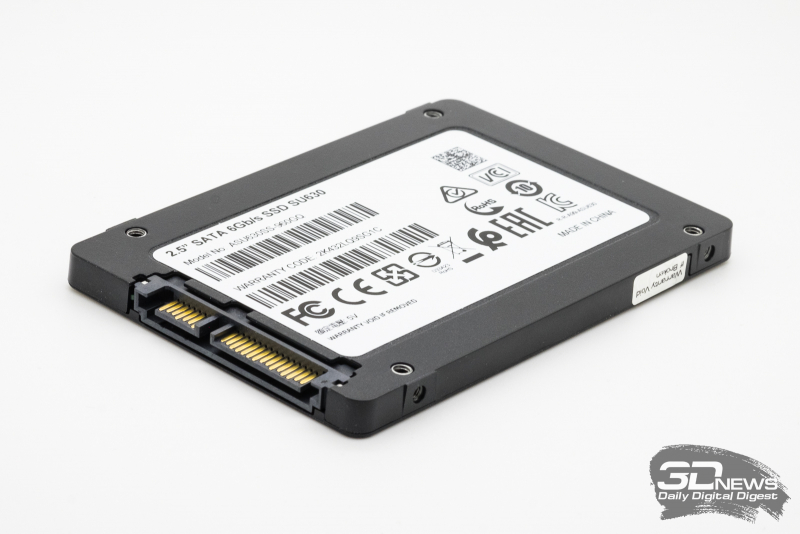
Because of this, the official specifications lose any meaning. For example, for the Ultimate SU630, the passport performance characteristics were probably formulated for a drive that is based on QLC 3D NAND. Accordingly, it is impossible to make an impression of the performance of a real SU630 from them.
| ADATA Ultimate SU630 960GB | |
|---|---|
| Linear read speed | 520 MB / s |
| Linear recording speed | 450 MB / s |
| Random read speed | 40 IOPS |
| Random write speed | 65 IOPS |
| Recording resource | 200 TB |
| Mean time between failures | 2 million h |
| Warranty | 3 years |
However, it is rather difficult to understand anything about the performance of the Ultimate SU630 based on the results of CrystalDiskMark. The applied Realtek RTS5732DLQ controller, although it does not have a DRAM interface and does not buffer accesses in the “RAM” memory, copes well with processing small amounts of information due to SLC caching of both writes and reads.

As a result, CrystalDiskMark confirms that the Ultimate SU630 and SU650 are very similar in performance. And they also have the same problems – when reading large amounts of data stored on SSD for a long time and missing in the SLC cache, the speed can drop one and a half times. A similar situation is observed when writing, when the volume of the dynamically allocated SLC cache comes to an end – when writing directly to the TLC array, the performance is only 50-55 MB / s.
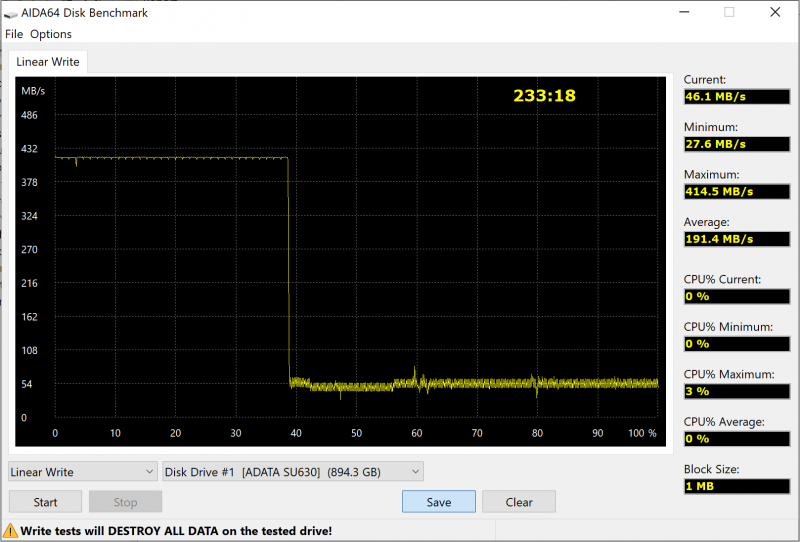
At the same time, the Ultimate SU630 and SU650 cannot be equated due to the terms of the warranty. Assuming the SU630 is a QLC drive, ADATA declares a very small rewrite resource for it, allowing the drive to be updated no more than 200 times. The warranty conditions for almost the same SU650 are much more liberal.
⇡ # Crucial MX500
The Crucial MX500 is a truly legendary drive that has been on the market since 2017. Moreover, to the credit of Crucial, its filling has since changed exclusively towards improvement. The original SMI SM2258 controller has been replaced by an optimized SM2259, and instead of the 64-layer TLC 3D NAND that was used initially, a newer 96-layer memory with a similar three-bit organization is now used.

All this makes the Crucial MX500 quite solid and predictable SATA SSD, of which there are not so many in the current environment. However, it cannot be considered a flagship SATA solution: the SM2259 controller has only four channels. But at least the design of this drive provides a full-fledged 1 GB DRAM buffer.
| Crucial MX500 | Stated | Actually |
|---|---|---|
| Capacity | 1 TB | 932 GiB |
| Controller | — | SMI SM2259 |
| DRAM | — | 1024 MB DDR3 SDRAM |
| NAND | Micron 3D NAND | Micron 96-layer 512Gb TLC 3D NAND |
Because the Crucial brand is owned by Micron, Crucial drives always use Micron’s NAND exclusively. This feature sets the Crucial MX500 apart from drives like the ADATA Ultimate SU800 or Kingston KC600, which also use SM2258 / SM2259 controllers, but memory options are more varied. In addition, Crucial traditionally develops firmware on its own, so its drives differ in operating algorithms.
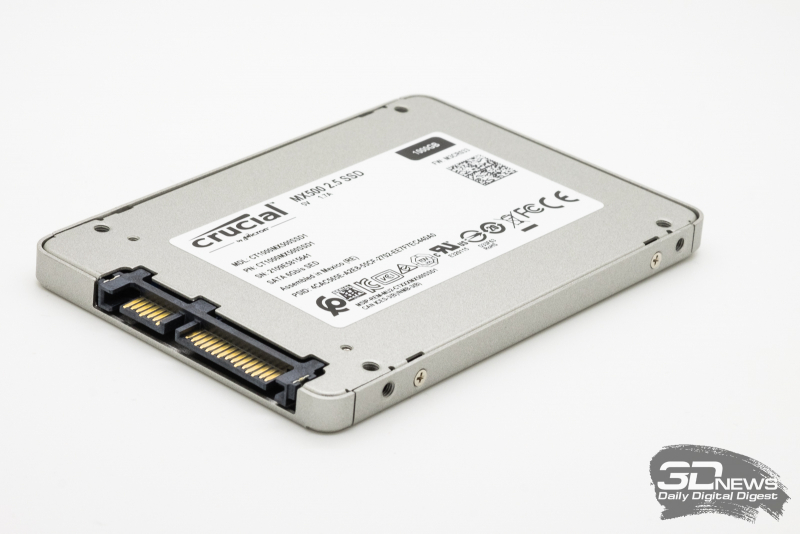
In part, this can be traced in the passport characteristics, which are higher for the Crucial MX500 than for similar SSDs on the same controller.
| Crucial MX500 1TB | |
|---|---|
| Linear read speed | 560 MB / s |
| Linear recording speed | 510 MB / s |
| Random read speed | 95 IOPS |
| Random write speed | 90 IOPS |
| Recording resource | 360 TB |
| Mean time between failures | 1,8 million h |
| Warranty | 5 years |
However, amid the high performance figures that the Crucial MX500 is trying to match the Samsung 870 EVO, this drive comes as an unpleasant surprise with rather poor warranty terms. Yes, its lifespan reaches 5 years, but at the same time, the volume of the SSD is allowed to be rewritten only 360 times, as if the MX500 is based not on high-quality TLC 3D NAND, but on cheap QLC memory.
As for the performance specifications, they noticeably exceed the numbers given by CrystalDiskMark, although in general the results of the synthetic test cannot be called low.
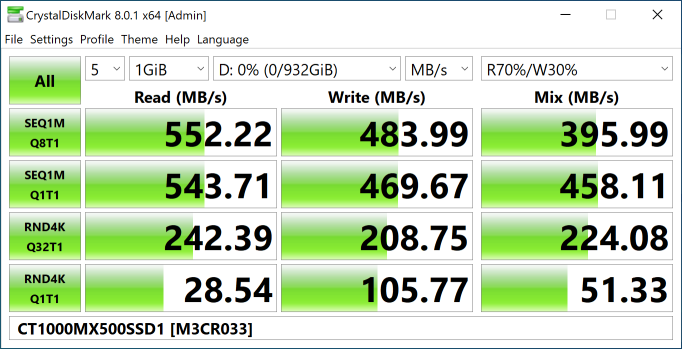
However, CrystalDiskMark reveals a relatively low read speed for small-block out-of-order requests. This is due to the fact that SLC caching in the MX500 works only for writing, and the read speed in this drive is always stable and predictable – there is no overestimation in synthetic tests.
The array of flash memory, assembled on the basis of 16 devices of 96-layer TLC 3D NAND manufactured by Micron, turns out to be fast enough so that the performance drop during linear writing to the SLC cache and beyond is almost not noticeable.

In terms of fill rate, the Crucial MX500 barely lags behind the leading SATA SSDs.
⇡ # Crucial BX500
While in the MX500, Micron, which owns the Crucial brand, demonstrates exemplary attitude to the stability of the hardware platform, in the BX500 we see a completely different approach. This drive belongs to budget solutions, and in it the manufacturer does not hesitate to replace memory with clearly worse options.
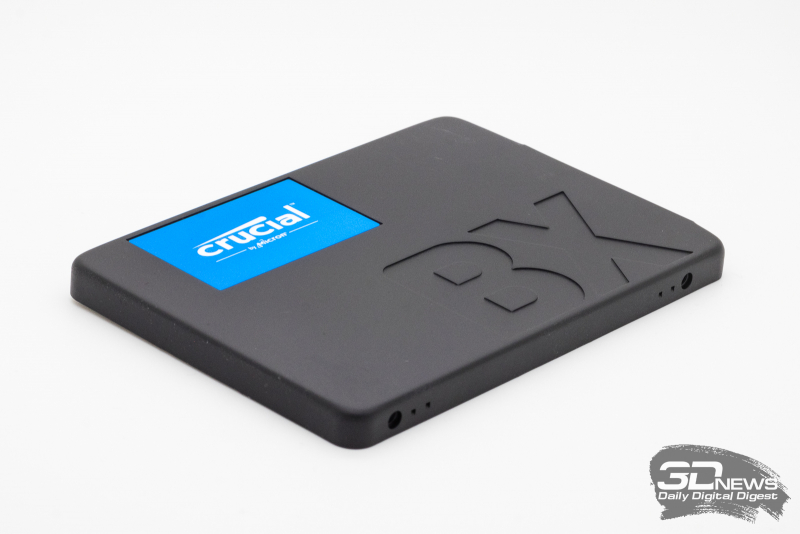
The terabyte version of the Crucial BX500 came out in early 2019 and it was a low-cost TLC 3D NAND-based bufferless drive. That is, the simplification of the BX500 over the MX500 was solely in the absence of a heap-based buffer. However, the BX500 that we got this time is a completely different drive, since it was based not on TLC, but on QLC 3D NAND.
| Crucial BX500 | Stated | Actually |
|---|---|---|
| Capacity | 1 TB | 932 GiB |
| Controller | — | SMI SM2259XT |
| DRAM | — | No |
| NAND | Micron 3D NAND | Micron 96-layer 1024-Gbps QLC 3D NAND |
Thus, in the BX500, the manufacturer managed to assemble almost the weakest configuration of all possible: here there is a bufferless design and a four-bit flash memory. We can only hope that the situation can be somehow smoothed out by the SM2259XT controller, which differs from the simplest chips by four-channel operation with an array of flash memory.

Curiously, for the Crucial BX500, the manufacturing company decided not to announce speeds at all when working with 4 KB blocks. This is a clear sign that the machinations with the stuffing of this drive were foreseen from the very beginning.
| Crucial BX500 1TB | |
|---|---|
| Linear read speed | 540 MB / s |
| Linear recording speed | 500 MB / s |
| Random read speed | — |
| Random write speed | — |
| Recording resource | 360 TB |
| Mean time between failures | 1,5 million h |
| Warranty | 3 years |
At first glance, the CryctalDiskMark synthetic benchmark does not give any suspiciously low results. Only the indicators obtained in mixed operations can be alarming. But do not forget that the flaws of the bufferless design in synthetics are usually poorly visible, and QLC memory is masked due to SLC caching.
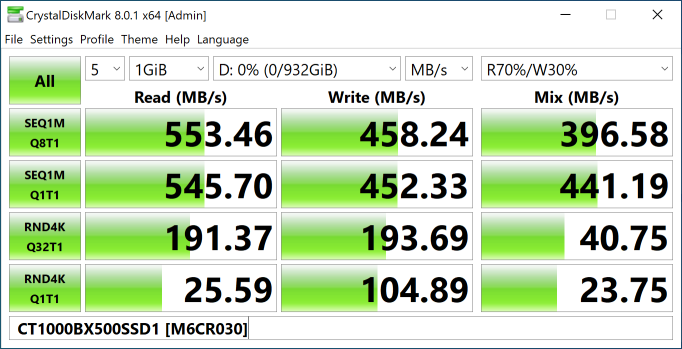
All the weaknesses of such a drive are manifested in large amounts of data. Linear write speed can drop down to 50 MB / s, and small-block read speed – up to 10-15 MB / s.
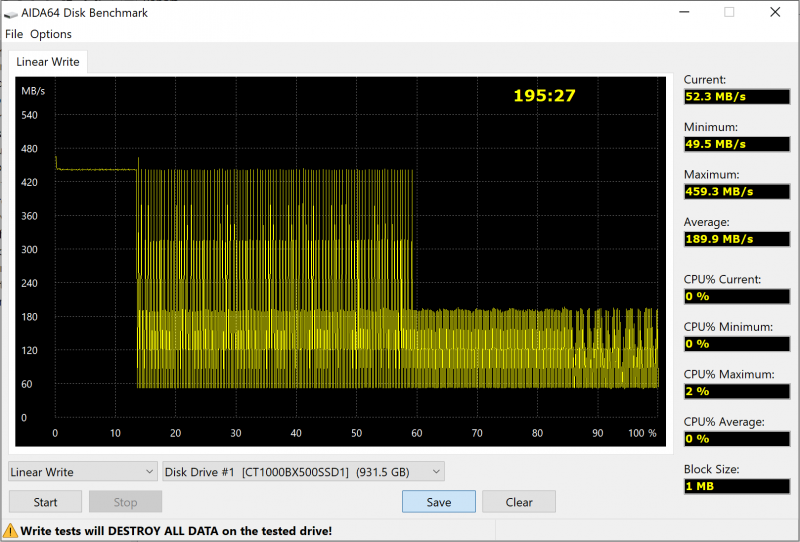
At the same time, the “comb” on the graph indicates that direct writing to QLC memory is not supported in the BX500 – operations are performed only through the cache, which further reduces performance when it is full. In other words, the Crucial BX500 can only be suitable for light workloads where small amounts of data are read or written, and where mixed operations are as small as possible.
⇡ # GoodRAM IRDM Pro Gen.2
Among modern SSDs with a SATA interface, there are very few options that have a predictable and stable configuration, and even fewer options that can be described with the epithet “flagship”. But GoodRAM IRDM Pro Gen.2 is one of those drives that can be opposed to the “reference” Samsung 870 EVO. That is why he got into this test, despite the fact that the share of GoodRAM in the domestic SSD market is almost invisible.

The secret behind IRDM Pro Gen.2’s appeal lies in the Phison PS3112-S12 controller, one of the best publicly available SATA SSD chips at the moment. This controller is based on a dual-core ARM processor with a frequency of 667 MHz, interacts with an array of flash memory on eight channels and has a high-speed DRAM interface for implementing a buffer. In IRDM Pro Gen.2, this controller is armed with an array of 16 TLC 3D NAND devices from Micron, which allows it to unleash its performance well.
| GoodRAM IRDM Pro Gen.2 | Stated | Actually |
|---|---|---|
| Capacity | 1024 GB | 954 GiB |
| Controller | Phison PS3112-S12 | Phison PS3112-S12 |
| DRAM | — | 512 MB DDR3 SDRAM |
| NAND | TLC 3D NAND | Micron 96-layer 512Gb TLC 3D NAND |
The advanced configuration of IRDM Pro Gen.2 is fixed in its official specifications – they explicitly indicate the controller and indicate the use of three-bit memory. However, nothing is said about the DRAM buffer, which allows the manufacturer to save a little and install not 1 GB, but 512 MB of memory to store a copy of the address translation table.
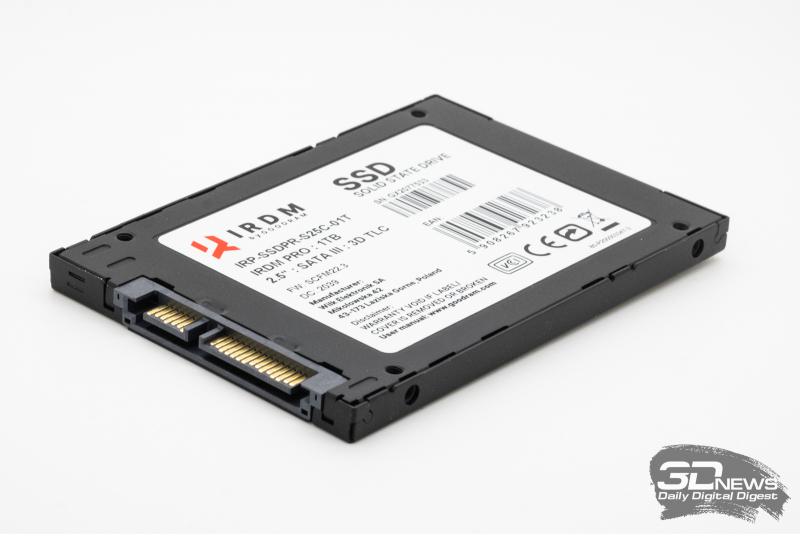
However, this did not stop GoodRAM from promising world-leading SATA SSD performance figures for its drive.
| GoodRAM IRDM Pro Gen.2 1024 GB | |
|---|---|
| Linear read speed | 555 MB / s |
| Linear recording speed | 535 MB / s |
| Random read speed | 92 IOPS |
| Random write speed | 86 IOPS |
| Recording resource | 870 TB |
| Mean time between failures | 1,5 million h |
| Warranty | 5 years |
But it is much more interesting that the GoodRAM drive looks very confident in CrystalDiskMark and does not yield to the Samsung flagships, not only in basic indicators, but even in mixed operations performance.
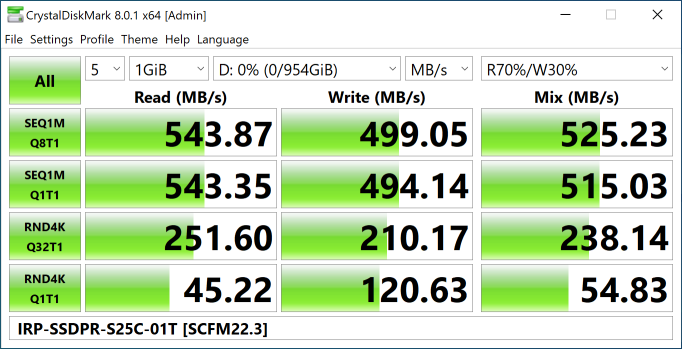
However, do not forget that the performance of the synthetic test has been improved by the SLC caching technologies implemented in Phison PS3112-S12. And if caching does not help with linear operations, since the eight-channel TLC 3D NAND array is fast by itself, then when reading from files that have been stored on the SSD for a long time, the speed is 33 MB / s. The SLC cache itself is static, its volume is about 25 GB.

Match performance and endurance indicators. The flagship nature of IRDM Pro Gen.2 is backed by a five-year warranty and a lifetime that exceeds the declared reliability of any other drive except, perhaps, the Samsung 860 PRO, based on MLC 3D NAND.
⇡ # HP SSD S700 Pro
Solid state drives under the HP brand are produced by the Chinese company BIWIN. However, you should not treat them with disdain because of this. During its presence in the market, this company has proven that it can offer solutions that are very interesting in terms of price and performance, using various Silicon Motion development platforms.
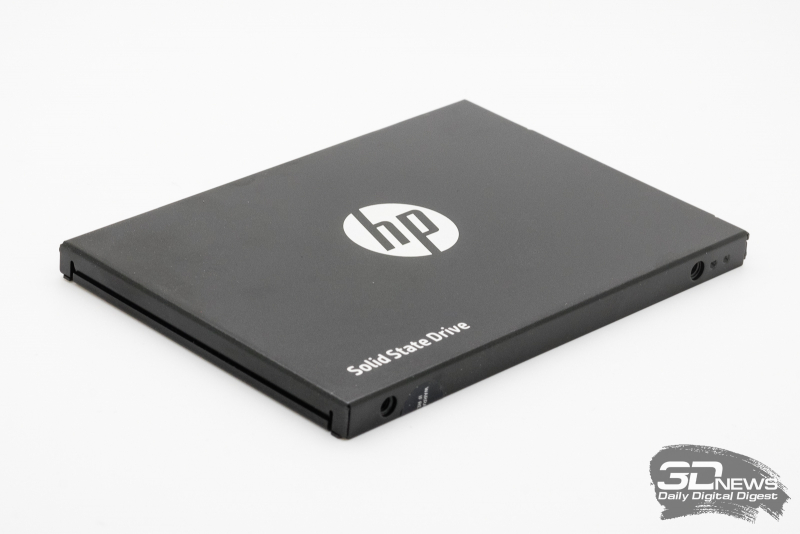
The HP SSD S700 Pro is a fairly old model, it has been present on the American market since 2017, but recently it began to be regularly supplied to Russia. And what is very gratifying, during the existence of this model, its hardware filling has practically not changed. Consequently, the S700 Pro is another stable SATA SSD variant that is not subject to unexpected design changes. From the beginning, it was a mid-range TLC 3D NAND-based drive, and it remains so to this day.
| HP SSD S700 Pro | Stated | Actually |
|---|---|---|
| Capacity | 1024 GB | 954 GiB |
| Controller | — | SMI SM2258 |
| DRAM | 1 GB | 1024 MB DDR3 SDRAM |
| NAND | 3D NAND | Micron 64-layer 512Gb TLC 3D NAND |
Even the controller has not changed since 2017 – the HP SSD S700 Pro is based on the four-channel SMI SM2258, although many other manufacturers have replaced this microcircuit with the newer SM2259 chip. However, the difference between them is small, and in general, we can say about the HP SSD S700 Pro that it is in many ways similar to the Crucial MX500, but the closest relative of this SSD is the ADATA Ultimate SU800.

Although the filling of the HP SSD S700 Pro is a drive of no more than an average level, the official specification indicates unrealistically high performance indicators for it. For a SATA SSD with a four-channel controller, DRAM buffer and TLC memory, they seem clearly overpriced.
| HP SSD S700 Pro 1024 GB | |
|---|---|
| Linear read speed | 570 MB / s |
| Linear recording speed | 525 MB / s |
| Random read speed | 95 IOPS |
| Random write speed | 105 IOPS |
| Recording resource | 650 TB |
| Mean time between failures | 2,0 million h |
| Warranty | 3 years |
CrystalDiskMark is of the same opinion regarding the performance of the HP SSD S700 Pro. Even in this synthetic test, the numbers are definitely lower than those given in the table. This is especially true for performance in small-block and mixed operations.
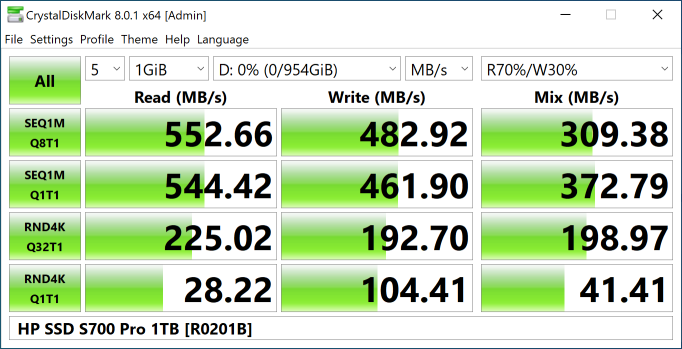
Nonetheless, CrystalDiskMark’s low 4-KB read speed in blocks without a request should not be disappointing. SLC caching in the HP SSD S700 Pro does not cover read operations, so the benchmark performance is fair and okay. Caching is invisible even with linear recording. The four-channel array of 64-layer Micron TLC 3D NAND is quite capable of receiving data at the maximum speed for the SATA interface, including in TLC mode.
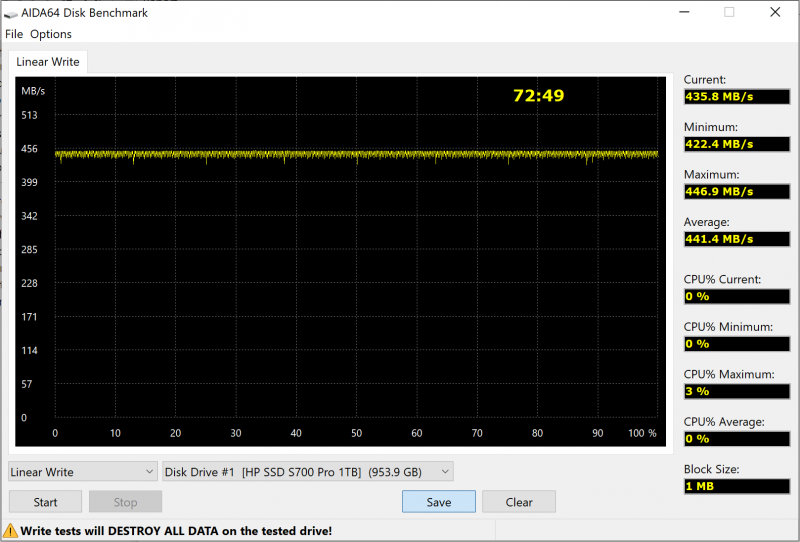
The full capacity of the HP SSD S700 Pro can be fully written with data in 73 minutes, and this is a good result. The best SATA SSDs only fill up 5 minutes faster.
⇡ # HP SSD S750
HP’s drive lineup is oddly organized, with a higher model number corresponding to lower performance. Therefore, while the HP S700 Pro SSD looked like a mid-range SSD, the HP S750 SSD is closer to the budget models.

However, the company BIWIN, which is a manufacturer of HP drives, still did not go down to using QLC memory even in its junior model. The S750 is a budget drive, but a TLC drive. Savings are achieved in this case due to the use of the SMI SM2259XT controller, devoid of the DRAM interface and, accordingly, the buffer memory for storing a quick copy of the address translation table.
| HP SSD S750 | Stated | Actually |
|---|---|---|
| Capacity | 1024 GB | 954 GiB |
| Controller | — | SMI SM2259XT |
| DRAM | — | No |
| NAND | 3D NAND | Intel 96-layer 512-Gbps TLC 3D NAND |
It should be borne in mind that the use of TLC 3D NAND in the drive is not in question in the official specification. Therefore, there is no guarantee that at some point QLC memory will not appear in the S750, as, for example, happened with the popular Crucial BX500.
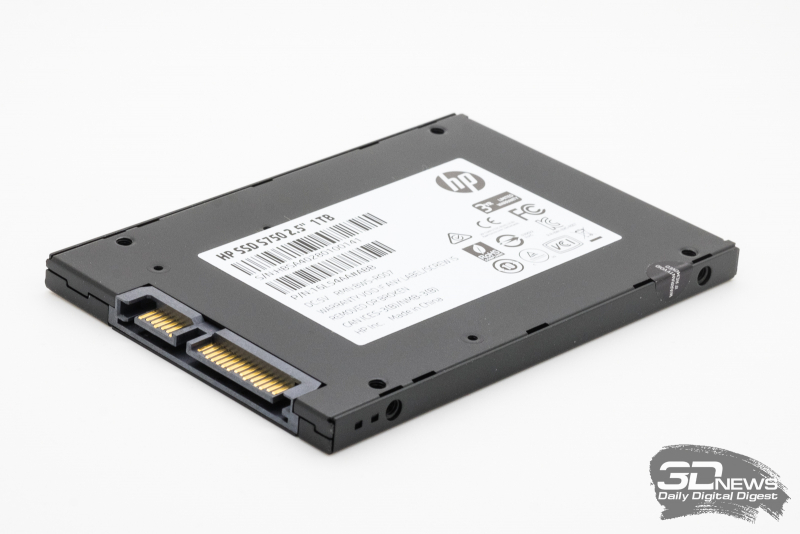
Nevertheless, the performance characteristics that BIWIN recorded for the S750 model on its website clearly suggest that we are talking about a drive with faster TLC memory, and not a slow QLC 3D NAND.
| HP SSD S750 1024 GB | |
|---|---|
| Linear read speed | 560 MB / s |
| Linear recording speed | 520 MB / s |
| Random read speed | 74 IOPS |
| Random write speed | 80 IOPS |
| Recording resource | 500 TB |
| Mean time between failures | 2,0 million h |
| Warranty | 3 years |
The drive is promised endurance of 500 TB, and this is clearly higher than it is customary to declare for SSD on four-bit memory. QLC drives also cannot deliver a peak performance of 74 thousand IOPS on random reads. In other words, by indirect indications, TLC 750D NAND should continue to be preserved in the HP S3.
But the test results in CrystalDiskMark unmistakably give a bufferless SMI controller – just look at the failure performance of mixed operations.
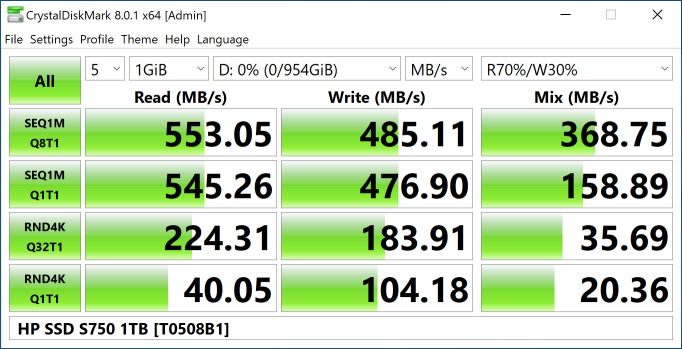
At the same time, the HP SSD S750 does not show a noticeable performance drop during long linear operations, since its TLC 3D NAND array has almost enough bandwidth to fill the SATA interface. The SLC cache itself is quite small and has a maximum size of around 40 GB.
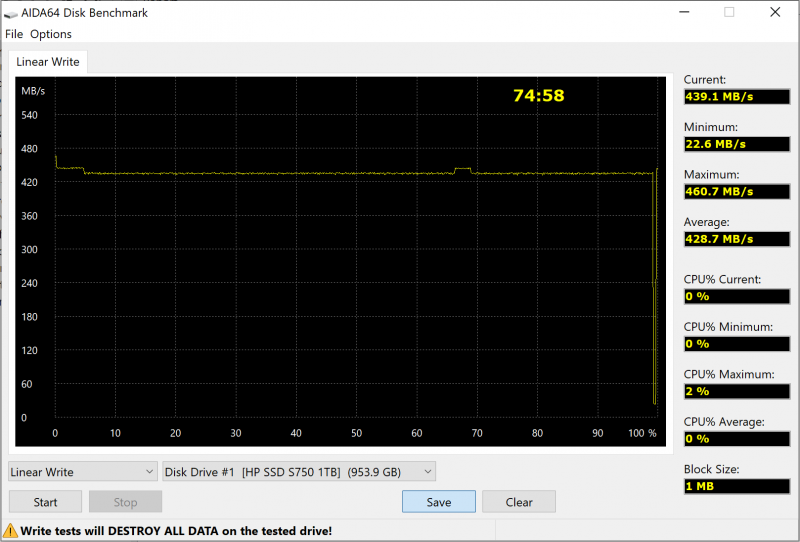
However, when reading randomly outside the SLC cache, which in the S750 works according to a dynamic scheme, the speed is about half that shown in the CrystalDiskMark screenshot. This means that it is not worth judging the performance of the HP SSD S750 by the performance of the synthetic test, and such a drive is poorly suited for intensive loads, which will clearly be seen in further tests.
⇡ # Kingston KC600
Introduced in 2019, the Kingston KC600 is one of the pre-configured offerings that are fixed in the specifications and are not subject to sudden changes in response to changing market conditions. SSDs of this kind immediately evoke sympathy, because here the buyer is insured against all kinds of surprises.
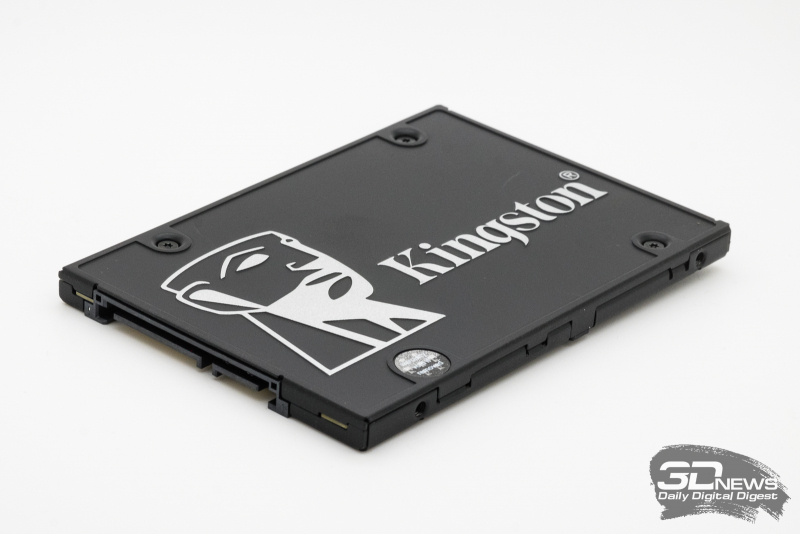
True, although the KC600 is an older SATA solution from the options offered by Kingston, it would be more correct to refer to it as a mid-range offering. In terms of hardware configuration, the KC600 should be considered a relative of the Crucial MX500 – Kingston also uses a four-channel SMI SM2259 controller and flash memory with three-bit cells. This configuration is not bad, but it does not allow achieving the level of performance that Samsung’s “reference” drives provide.
| Kingston KC600 | Stated | Actually |
|---|---|---|
| Capacity | 1024 GB | 954 GiB |
| Controller | SMI SM2259 | SMI SM2259 |
| DRAM | — | 1024 MB DDR3 SDRAM |
| NAND | TLC 3D NAND | Micron 96-layer 512Gb TLC 3D NAND |
It is curious that even the flash memory is identical with the Crucial MX500 in the Kingston KC600. However, drives still differ at the firmware level – both manufacturers make their own optimizations at the software level.
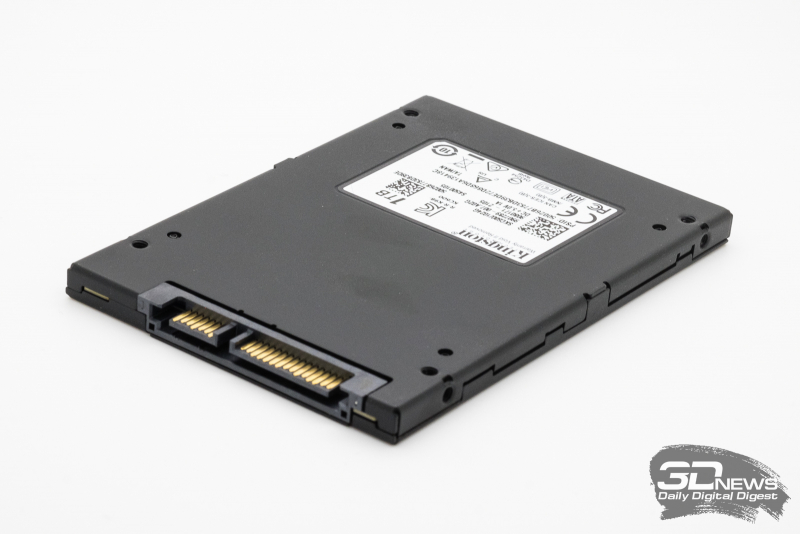
Perhaps that is why the passport characteristics related to speed of the Kingston KC600 are slightly worse than the variant offered by Crucial. But in compensation, Kingston offers better warranty conditions, promising 1,7 times more rewrite life.
| Kingston KC600 1024 GB | |
|---|---|
| Linear read speed | 550 MB / s |
| Linear recording speed | 520 MB / s |
| Random read speed | 90 IOPS |
| Random write speed | 80 IOPS |
| Recording resource | 600 TB |
| Mean time between failures | 1,0 million h |
| Warranty | 5 years |
However, if you look at the numbers given by the synthetic tests, then there is no lag between the Kingston KC600 and its Crucial counterpart. On the contrary, it feels like we just tested the same SSD twice.
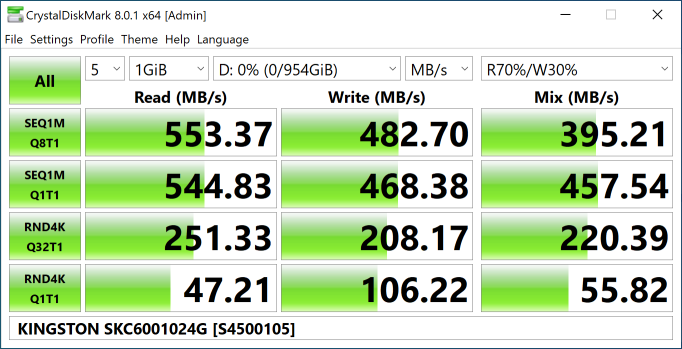
Here it will be appropriate to remind once again that tests like CrystalDiskMark do not give a complete picture of performance, because they can “probe” the exceptional performance of an SSD when working with an SLC cache. And if during linear operations the speed of the flash memory array in the KC600 is enough to ensure almost full use of the SATA interface bandwidth without caching, then the performance of small-block reads without a request queue can “sag” to about 35 MB / s.
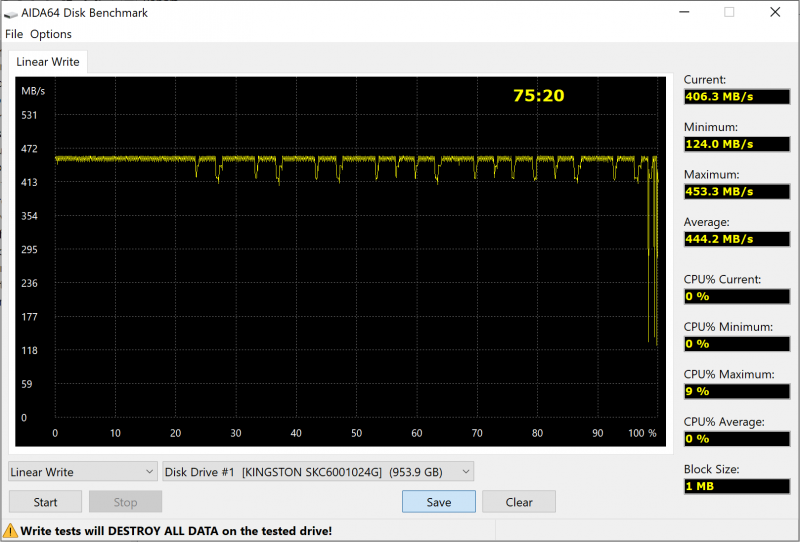
The linear write speed graph looks somewhat unusual – it contains chaotically located small performance gaps. Such fluctuations in performance occur in defective cells of flash memory, and for some reason the SMI SM2259 controller hardly masks them.
⇡ # Kingston A400
Kingston A400 is one of the best-selling drives in Russia, although this applies to the versions of the minimum capacity achieved at the expense of a very low price… At the same time A400 is presented in terabyte (and even two terabyte) volume, and this is also an ultra-budget model.
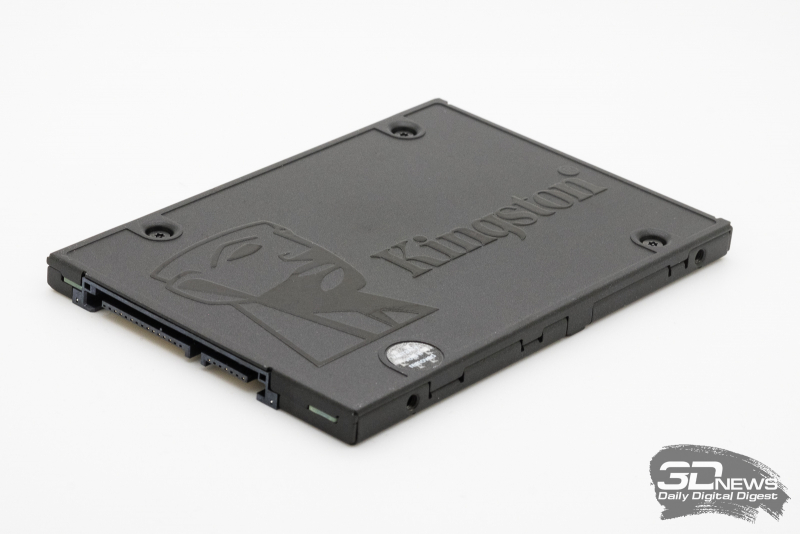
As with other cheap SSDs, the Kingston A400 does not have any specific design fixed in the specifications. Such a drive contains the filling that the manufacturer managed to find on the market at a lower price. When the A400 hit the market in 2017, it was a bufferless TLC 3D NAND SSD, but today it already uses cheaper 3111-bit memory, and that’s no surprise. But the controller, oddly enough, remains the same, and this is the Phison PS11-SXNUMX.
| Kingston A400 | Stated | Actually |
|---|---|---|
| Capacity | 960 GB | 894 GiB |
| Controller | — | Phison PS3111-S11 |
| DRAM | — | No |
| NAND | 3D NAND | Intel 64-layer 1024-Gbps QLC 3D NAND |
Thus, in the A400, Kingston offers the weakest configuration for today: a bufferless SSD based on QLC memory, and even based on a single-core dual-channel controller.
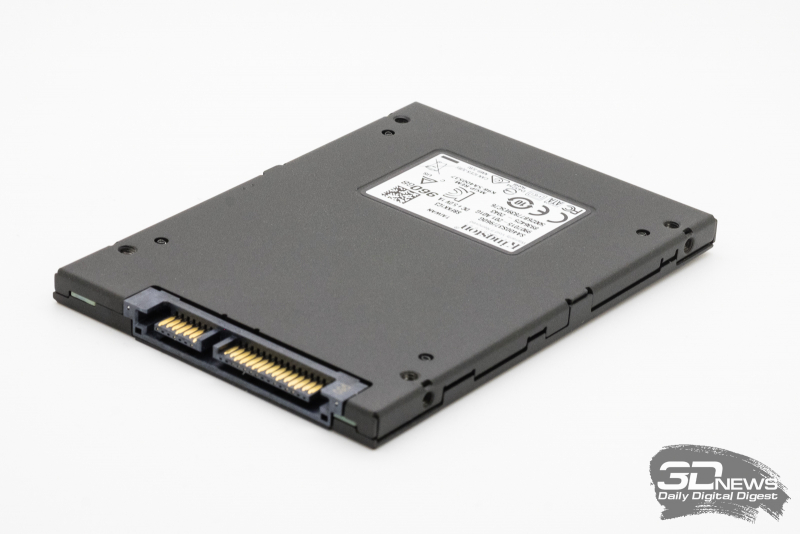
There is no reason to expect any promising performance indicators from such a drive. And that’s why Kingston’s spec sheet is shyly silent about the small-block performance specs. Obviously, if you list them honestly, they will scare away rather than attract potential buyers.
| Kingston A400 960 GB | |
|---|---|
| Linear read speed | 500 MB / s |
| Linear recording speed | 450 MB / s |
| Random read speed | — |
| Random write speed | — |
| Recording resource | 300 TB |
| Mean time between failures | 1,0 million h |
| Warranty | 3 years |
However, if you look at the numbers reported by the standard CrystalDiskMark benchmark for the Kingston A400, the performance does not seem so low. At the very least, this drive does not have the obvious mixed-load performance issues that many other non-buffered SSDs have.
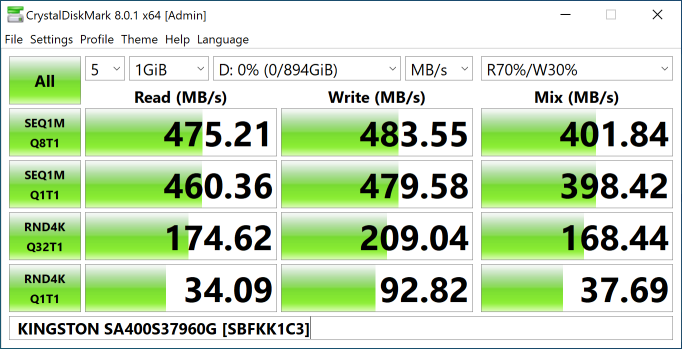
In general, the Kingston A400 is comparable to other budget SATA SSDs like the Crucial BX500 or lower-end ADATA drives. As with other SSDs of this level, the architectural flaws of the A400 are well hidden behind dynamic SLC caching algorithms. But if you dig a little deeper, it turns out that the speed of direct linear write to QLC memory can drop to 25 MB / s, and filling the entire Kingston A400 with a volume of 1 TB will take more than seven hours.
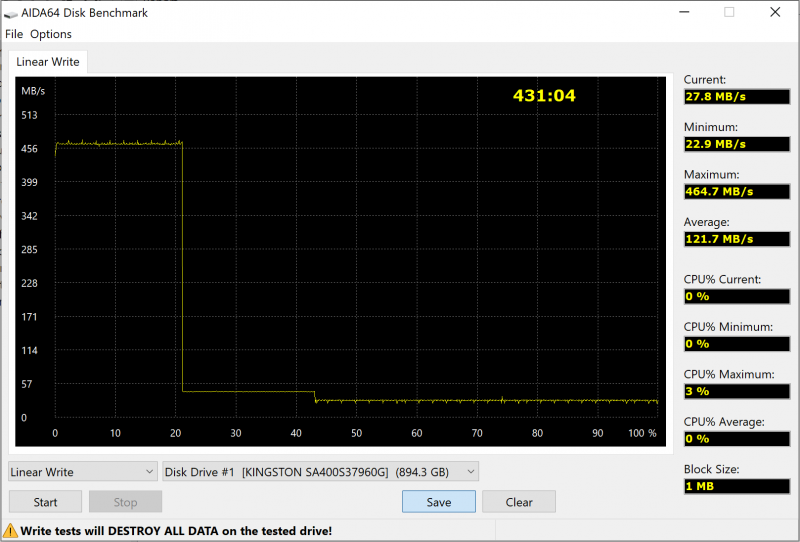
A drop in performance is also observed when reading large amounts of data in small block. In this case, instead of 34 MB / s, which CrystalDiskMark shows, you can get a speed of about 24 MB / s.
The warranty conditions for the Kingston A400 are absolutely typical for a QLC SSD. Within three years, the volume of the drive is allowed to be rewritten no more than 300 times.
⇡ # Patriot P210
The main trump card of Patriot SATA products is attractive prices. For its proposals, the local company chooses the most inexpensive configuration options, and therefore does not fix them in most models. In other words, Patriot may offer fundamentally different products under the same name.

For example, the Patriot P210, although it was presented relatively recently, has already been seen with different controllers and with different memory, including four-bit. However, we were lucky – for this testing we came across far from the worst configuration: the SMI SM2259XT controller and TLC 3D NAND manufactured by Micron. This is, albeit a bufferless, but still a four-channel platform.
| Patriot P210 | Stated | Actually |
|---|---|---|
| Capacity | 1 TB | 954 GiB |
| Controller | — | SMI SM2259XT |
| DRAM | — | No |
| NAND | — | Micron 128-layer 512Gb TLC 3D NAND |
In this version, the Patriot P210 is similar to the HP SSD S750 and looks quite advantageous against the background of other budget proposals. However, it should be borne in mind that the weakness of the bufferless configurations and the SMI SM2259XT controller can manifest itself under serious (in terms of total file sizes) loads and mixed operations. In addition, the Patriot P210’s flash array is built from slower NAND devices than the HP S750 SSD.
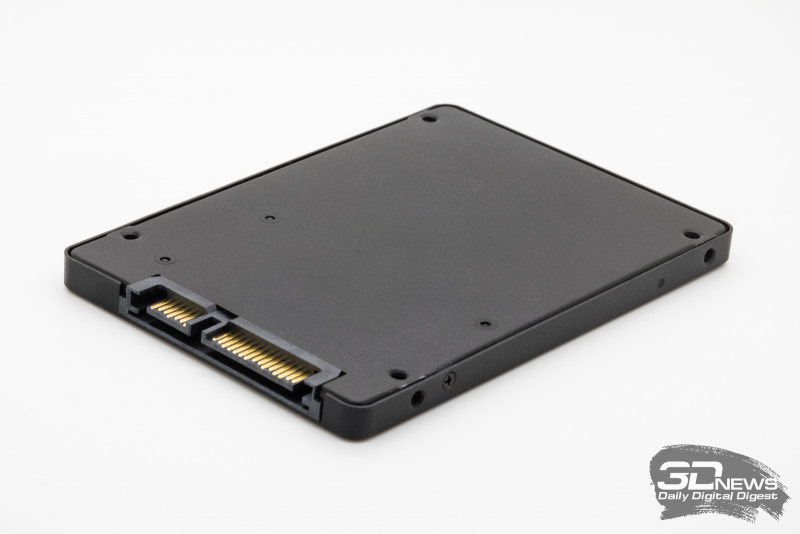
Therefore, it should not be surprising that the official specifications of the Patriot P210 are low performance values. And in this regard, Patriot behaves much more honestly – unlike other suppliers of bufferless SATA SSDs, this company does not try to attract users with implausible “add-ons”.
| Patriot P210 1 TB | |
|---|---|
| Linear read speed | 520 MB / s |
| Linear recording speed | 430 MB / s |
| Random read speed | 50 IOPS |
| Random write speed | 50 IOPS |
| Recording resource | — |
| Mean time between failures | — |
| Warranty | 3 years |
Nevertheless, it is still not very clear how seriously you can take the characteristics of a drive, the hardware configuration of which can be creatively rethought within very wide limits.
The CrystalDiskMark values for the Patriot P210 variation that came to our test are as follows.
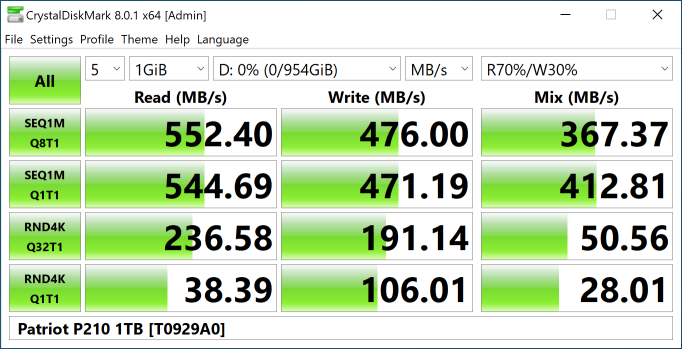
The calling card of the SMI SM2259XT controller is a failure in the performance of small-block mixed operations. Even SLC caching doesn’t help here. But with simple reads and writes, the Patriot P210 looks pretty good, since in this case the SLC cache is fully used. Therefore, you shouldn’t be surprised that in case of random access to data that was written to the drive a long time ago, the indicators will be lower than in the test.
The effect of the cache is also clearly visible during linear recording, since the direct write speed to the memory array is about 50 MB / s, despite the fact that it is built on TLC 3D NAND. Filling up the entire capacity of a terabyte Patriot P210 takes about four hours, as if it were a QLC drive.

It is worth noting separately that for the P210, the manufacturer, for some reason, did not specify the rewriting resource. This is very rare today and apparently means that the quality of flash memory in this drive can also be completely different.
⇡ # Patriot Burst
Unlike other Patriot drives, Burst is a model with at least some certainty regarding the hardware configuration. Its specs directly state: “The SSD is based on the Phison PS3111-S11 controller.” The use of this controller immediately indicates the approximate level of the device, since we are talking about a platform without a DRAM buffer and with a dual-channel memory array.
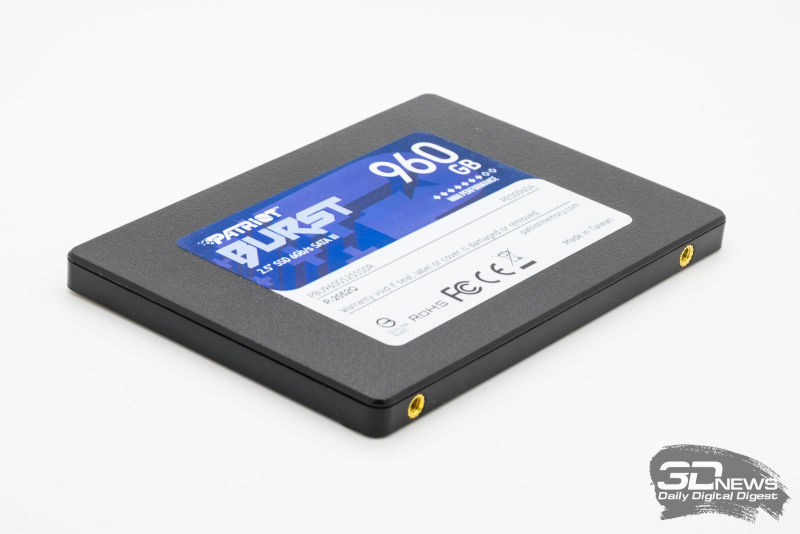
Unfortunately, besides the controller, the specification does not provide any other details. This allowed the manufacturer to take advantage of the remaining understatement and, in addition to the entry-level controller, install a slow 3D NAND QLC in Burst. At the same time, earlier in Burst it was possible to find TLC 3D NAND, and before that, planar TLC, but the final point of the evolution of the configuration of this drive brought it to the very bottom. Modern Burst is the worst possible option: a two-channel bufferless controller and slow four-bit memory converged in one product.
| Patriot burst | Stated | Actually |
|---|---|---|
| Capacity | 960 GB | 894 GiB |
| Controller | Phison PS3111-S11 | Phison PS3111-S11 |
| DRAM | — | No |
| NAND | — | Micron 64-layer 1024-Gbps QLC 3D NAND |
The configuration of the modern Burst completely repeats the filling of the phenomenally popular Kingston A400, while Patriot somehow managed to provide its product with an even more attractive price.
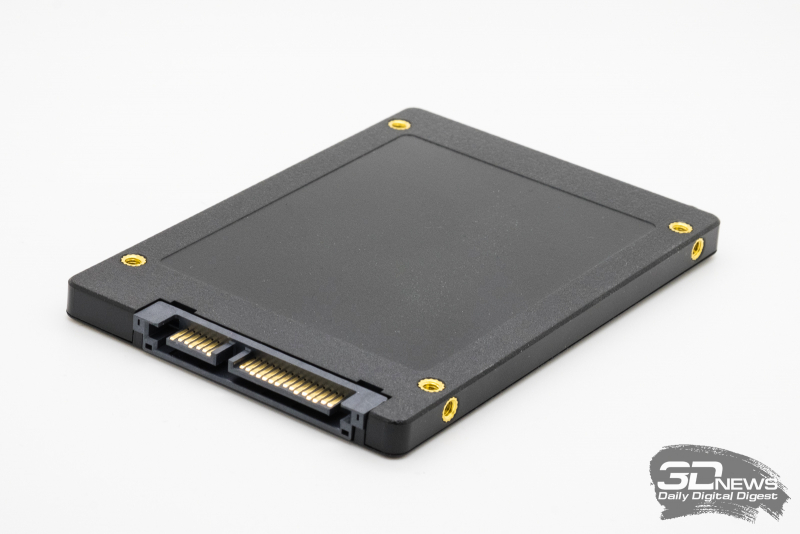
However, the performance metrics listed in the Patriot Burst specification are somewhat confusing. It is quite obvious that this drive should be worse in speed than the P210, but judging by the numbers from the Patriot website, everything is exactly the opposite.
| Patriot Burst 960 GB | |
|---|---|
| Linear read speed | 560 MB / s |
| Linear recording speed | 540 MB / s |
| Random read speed | 60 IOPS |
| Random write speed | 60 IOPS |
| Recording resource | 835 TB |
| Mean time between failures | 2,0 million hours |
| Warranty | 3 years |
It seems that the specification was formulated in the distant past, when Burst was installed with three-bit memory, and since then nothing has been changed on the site. This version is also supported by the high declared write resource, which exceeds the endurance of many TLC-based drives. Consequently, the official characteristics of the Patriot Burst have nothing to do with reality.
A more relevant picture is given by the synthetic test CrystalDiskMark. And it does show markedly lower speeds than those shown in the table above.

However, it should be noted that the Phison PS3111-S11 controller, despite its bufferless nature, copes quite well with mixed operations – here Burst outperforms the P210. But the rest of Burst’s performance numbers are clearly worse.
At the same time, Patriot Burst has SLC caching, which works according to a dynamic scheme. It is these algorithms that make it possible to hide the low performance of QLC memory, which, with direct linear recording, provides speeds no higher than 25-30 MB / s.
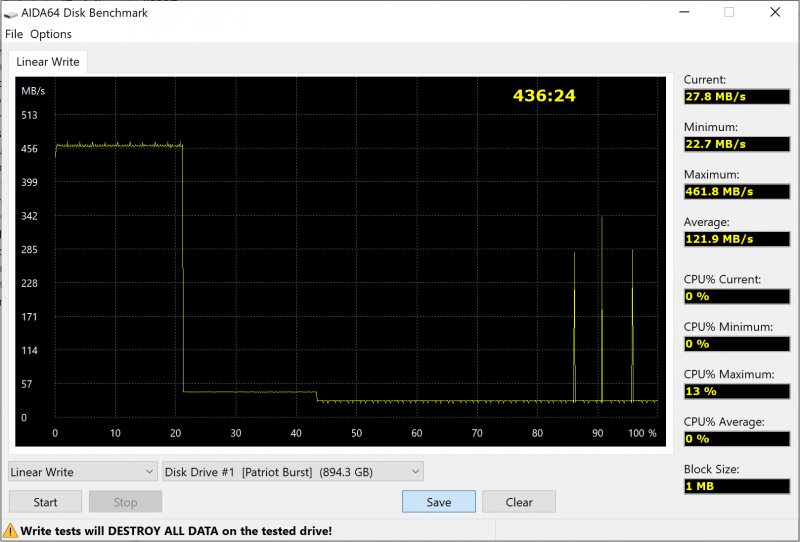
As a result, Patriot Burst is a budget drive for light workloads. But among the buffer-free QLC 3D NAND drives, it has one advantage. The Phison PS3111-S11 controller is the best among all non-buffered platforms to handle mixed and multi-threaded workloads, and in some workloads this can play in favor of Burst. However, this does not negate the fact that we are talking about a two-channel entry-level solution.
⇡ # Patriot Burst Elite
While the Patriot Burst Elite name sounds pretty promising, this drive is by no means an improved version of the regular Burst. On the contrary, in the description of this drive, the manufacturer has removed all the specifics regarding the configuration in order to be able to change the configuration as flexibly as possible. As a result, Burst Elite can be thought of as a random SSD made up of components that Patriot was able to purchase at a minimal price.

The version of Burst Elite that ended up in our lab was conceptually no different from the regular Burst. We got a similar SATA SSD with a bufferless controller and 3111-bit flash memory. However, instead of Phison PS11-S2259, this drive used a different controller – SMI SMXNUMXXT. On the one hand, this controller works with a four-channel flash array, which means better linear performance. But on the other hand, its power is clearly not enough with a mixed multithreaded load, on which it simply chokes.
| Patriot burst elite | Stated | Actually |
|---|---|---|
| Capacity | 960 GB | 894 GiB |
| Controller | — | SMI SM2259XT |
| DRAM | — | No |
| NAND | — | Intel 64-layer 1024-Gbps QLC 3D NAND |
This configuration turns the Patriot Burst Elite into a QLC-degraded version of the Patriot P210, which in turn is similar in structure to the Crucial BX500 drive.
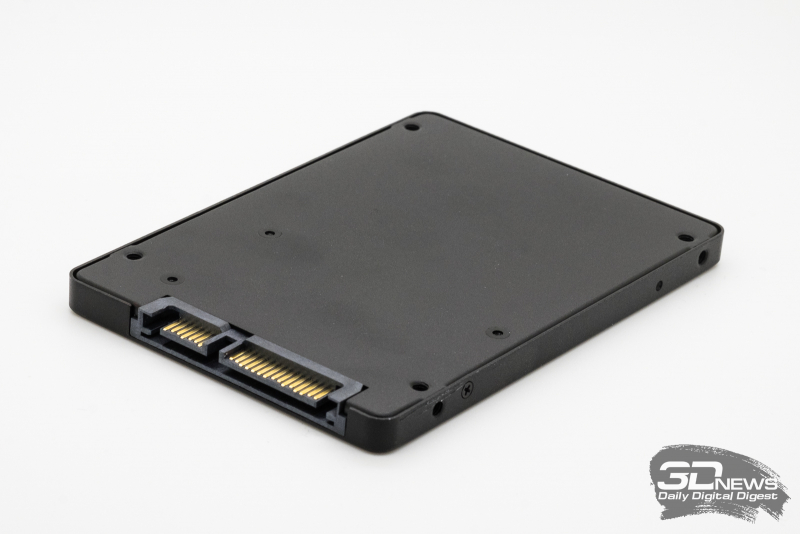
Since Burst Elite appeared in the Patriot lineup relatively recently, its specification was formulated immediately taking into account the use of QLC 3D NAND in it. Therefore, do not be surprised at the low numbers – they reflect the real capabilities of the SSD.
| Patriot Burst Elite 960 GB | |
|---|---|
| Linear read speed | 450 MB / s |
| Linear recording speed | 320 MB / s |
| Random read speed | 40 IOPS |
| Random write speed | 40 IOPS |
| Recording resource | 800 TB |
| Mean time between failures | 2,0 million hours |
| Warranty | 3 years |
However, if you compare the numbers from the table with the readings of the synthetic test CrystalDiskMark, then the suspicion creeps in that Patriot left room for itself so that the real performance of Burst Elite could be weakened even more. At least the line speeds in the test turn out to be noticeably higher than those promised.
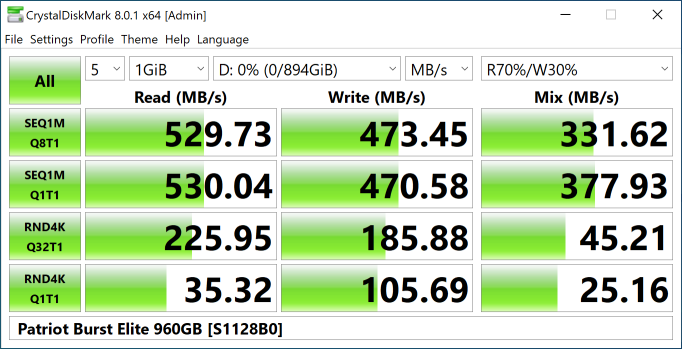
SMI SM2259XT is still a four-channel controller, which, with support from the SLC caching technology, can fill the bandwidth of the SATA interface without any problems.
The weakness of the Patriot Burst Elite can be seen in the CrystalDiskMark results in mixed operations speed. But in fact, this drive, like other bufferless solutions, has other problems as well. In particular, a serious decrease in performance when accessing large amounts of data is simply not designed for such scenarios. Against this background, it seems not so scary even that after the SLC cache capacity is exhausted, the linear write speed drops to 30 MB / s.

Strange enough in the characteristics of Burst Elite, the high rewrite resource looks – 800 TB. For some reason, Patriot promises more endurance for its QLC 3D NAND drive than a quality TLC 3D NAND drive. But it seems more likely that this number has nothing to do with reality than that Patriot finds some particularly reliable QLC memory for its drives.
⇡ # Samsung 860 PRO
Samsung 860 PRO is a truly legendary drive that appeared back in 2018 and has become a phenomenon unique to the SATA SSD market. The fact is that Samsung has chosen MLC 3D NAND memory for this SSD and does not change this choice, despite the fact that all other manufacturers have long since curtailed the supply of such models. And there is no doubt that Samsung is doing it right. Although the Samsung 860 PRO is two and a half times more expensive than, for example, the Kingston A400, it continues to enjoy considerable popularity. Users choose it based on the high level of performance and the highest reliability possible for a consumer SATA SSD.
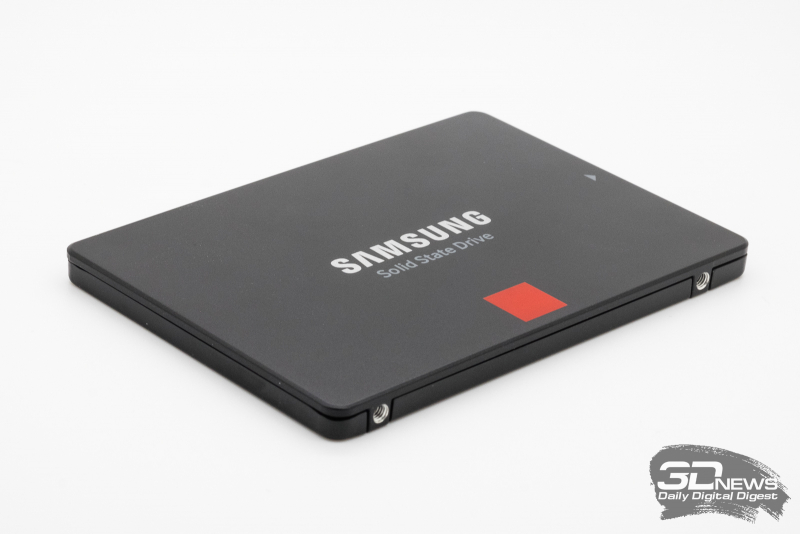
Samsung drives have won a positive attitude towards themselves also because in their specifications the manufacturer clearly and unambiguously indicates the hardware filling and always firmly follows these promises. Today’s Samsung 860 PRO is essentially no different from the 860 PRO that could have been bought three years ago, and this fundamentally distinguishes this model from most offers from other manufacturers, where memory, and sometimes controllers, change so that it is impossible to keep track of them.
At the heart of the Samsung 860 PRO is the eight-channel Samsung MJX controller, the same for the entire 860 series, as well as the proprietary 64-layer MLC 3D V-NAND. Naturally, the drive design also provides a full-fledged DRAM buffer, for which LPDDR4 memory is used.
| Samsung 860 PRO | Stated | Actually |
|---|---|---|
| Capacity | 1024 GB | 954 GiB |
| Controller | Samsung MJX | Samsung MJX |
| DRAM | 1 GB LPDDR4 | 1 GB LPDDR4 SDRAM |
| NAND | Samsung MLC V-NAND | Samsung 64-layer 256Gbps MLC 3D V-NAND |
Due to the use of memory with two-bit cells, the Samsung 860 PRO differs in many ways from other consumer SATA drives. Firstly, the MLC memory has high performance, and the 860 PRO does not need to use SLC caching. Secondly, the capacity of MLC 3D V-NAND devices is half that of typical TLC chips, which increases the degree of parallelism of the flash memory array and also has a positive effect on performance.
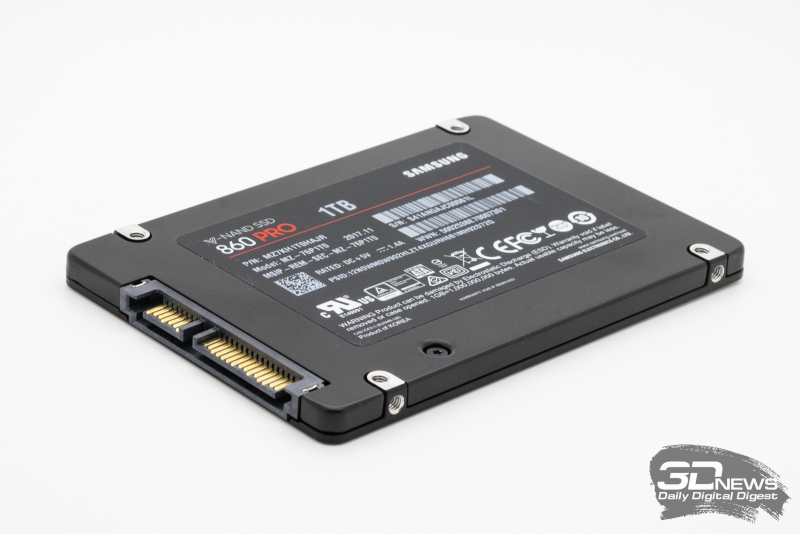
Therefore, it is not surprising that Samsung 860 PRO has announced very high performance indicators by the standards of SATA SSD.
| Samsung 860 PRO 1024 GB | |
|---|---|
| Linear read speed | 560 MB / s |
| Linear recording speed | 530 MB / s |
| Random read speed | 100 IOPS |
| Random write speed | 90 IOPS |
| Recording resource | 1200 TB |
| Mean time between failures | 1,5 million hours |
| Warranty | 5 years |
Along with the high speed, the Samsung 860 PRO also promises an outstanding rewriting capacity – more than any other SATA SSD. This is due to the endurance of the two-bit cells. It’s a shame Samsung dropped the 10-year warranty on the PRO series drives – the previous 850 PRO series stood out for that as well.
The high performance of the Samsung 860 PRO is confirmed in the synthetic benchmark CrystalDiskMark. And do not forget that all indicators were obtained without any SLC caching.
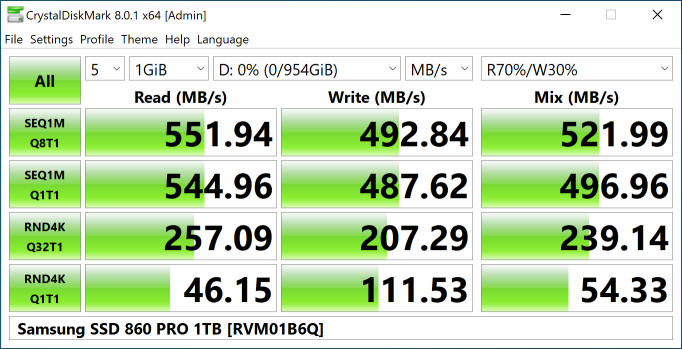
In other words, this is exactly the speed the Samsung 860 PRO delivers when working with any amount of data, which makes it the best option for intensive workloads. As a confirmation of this thesis, we can give a graph of the speed change during continuous linear recording to the full capacity of the SSD – here you can clearly see the excellent constancy of performance.

Separately, I would like to draw your attention to the fact that it takes less than 100 minutes for Samsung 860 PRO to fill 70% with data. This is almost the best result for a terabyte SATA SSD. For example, compare: it will take a user more than seven hours to complete the recording of the already mentioned Kingston A400.
⇡ # Samsung 870 EVO
The Samsung 870 EVO is one of the few SATA SSDs to hit the market in the last year. While most manufacturers still offer users older models that are gradually replacing internal components, Samsung is pursuing a different tactic. The company introduces completely redesigned hardware configurations to the market and promotes them under new brand names.
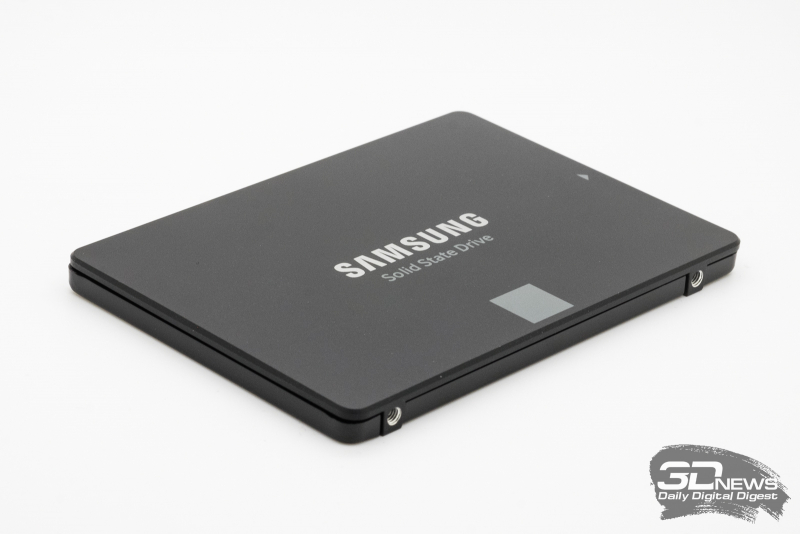
The foundation of the Samsung 870 EVO is the new 128-channel Samsung MKX controller with increased frequency and the new 3-layer TLC 870D V-NAND with reduced latencies. In general, the hardware circuitry of the 860 EVO remains the same as in the previous South Korean company’s bestseller, the 10 EVO, but the sum of the small improvements, as follows from the official specs, should have yielded about a XNUMX percent increase in performance.
| Samsung 870 EVO | Stated | Actually |
|---|---|---|
| Capacity | 1000 GB | 932 GiB |
| Controller | Samsung MKX | Samsung MKX |
| DRAM | 1 GB LPDDR4 | 1 GB LPDDR4 SDRAM |
| NAND | Samsung TLC V-NAND | Samsung 128-layer 512-Gbps TLC 3D V-NAND |
As you can see from the table, Samsung has described the configuration of the 870 EVO in the specification as detailed as possible, which means that no changes in the filling should be expected. If the company wants to improve or degrade this SSD, then it will obviously release a different model with a different name. Like the 870 QVO, which is literally the 870 EVO with QLC memory.
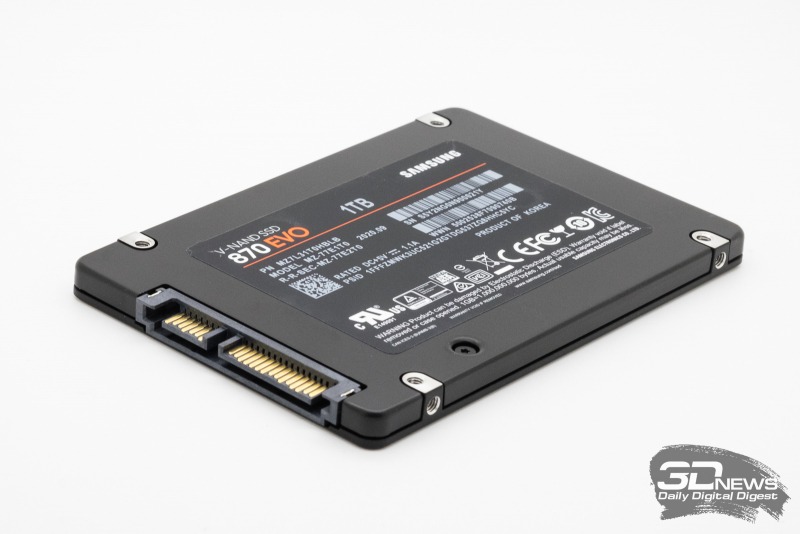
Despite the fact that the 870 EVO is the fastest SATA SSD with 860-bit memory from Samsung, its official specifications look slightly worse than that of the XNUMX PRO MLC drive.
| Samsung 870 EVO 1000 GB | |
|---|---|
| Linear read speed | 560 MB / s |
| Linear recording speed | 530 MB / s |
| Random read speed | 98 IOPS |
| Random write speed | 88 IOPS |
| Recording resource | 600 TB |
| Mean time between failures | 1,5 million hours |
| Warranty | 5 years |
But the synthetic test CrystalDiskMark has a different opinion.
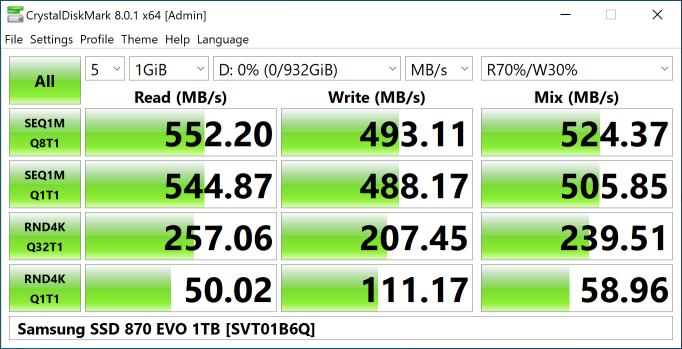
This is because the 870 EVO uses a more recent generation of flash memory with a faster external interface, plus SLC caching technology, which speeds up write operations. However, the eight-channel MKX controller can write to the TLC-memory array in its normal mode at a speed not lower than the SATA interface bandwidth. Therefore, it is almost impossible to notice during long linear recording, where switching between SLC and TLC modes occurs.
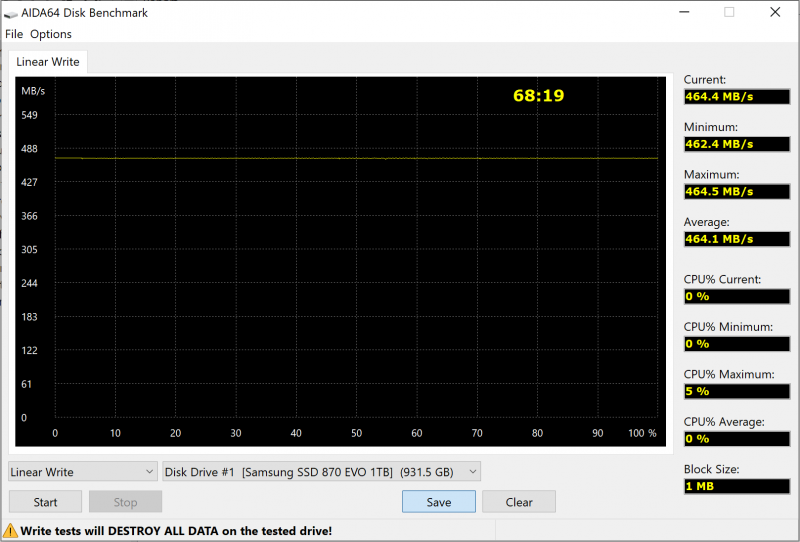
Thanks to this, the Samsung 870 EVO even slightly outperforms the 860 PRO in terms of the time required to fill the entire volume.
But Samsung 870 EVO loses to its MLC counterpart in the stated endurance. This SSD is guaranteed to be able to write only 600 TB of data, which, however, can be described as quite a typical resource for consumer SATA SSDs with TLC memory.
⇡ # Samsung 860 EVO
The Samsung 860 EVO is the predecessor of the Samsung 870 EVO, which has been formally discontinued. However, the accumulated warehouse stocks do not yet allow this drive to completely disappear from the shelves, and for this reason we included it in testing along with a more recent model.
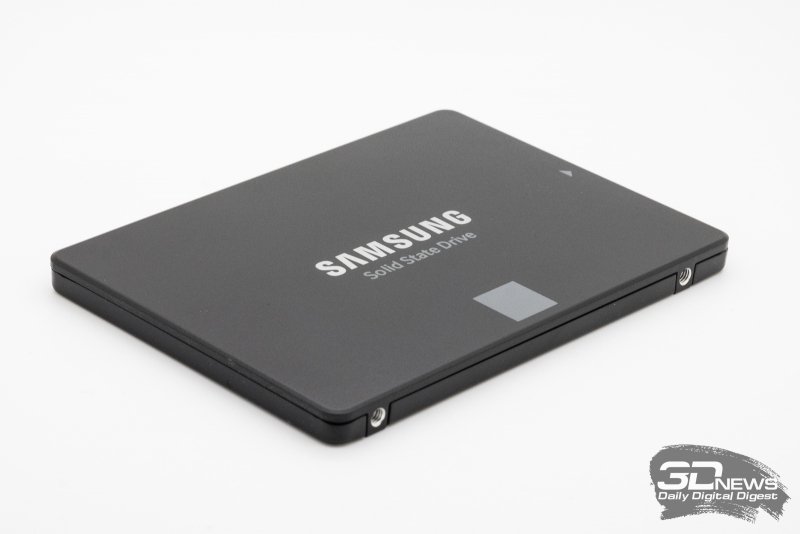
If Samsung had followed the same principles as other SSD manufacturers, the 860 EVO and 870 EVO would be one model, as the second drive represents a logical evolution of the first, without any radical configuration changes. Yes, the 860 EVO uses a slightly older controller and flash memory with fewer vertical layers, but conceptually the drives are the same. Both are SATA SSDs with TLC memory, built on the basis of a powerful eight-channel controller, reinforced with a DRAM buffer.
| Samsung 860 EVO | Stated | Actually |
|---|---|---|
| Capacity | 1000 GB | 932 GiB |
| Controller | Samsung MJX | Samsung MJX |
| DRAM | 1 GB LPDDR4 | 1 GB LPDDR4 SDRAM |
| NAND | Samsung TLC V-NAND | Samsung 96-layer 512-Gbps TLC 3D V-NAND |
The Samsung 860 EVO uses the same MJX controller as the 860 PRO, and flash memory is one generation behind the 870 EVO’s NAND devices. By the way, since the Samsung 860 EVO was released in early 2018, a slightly different type of memory was initially installed in it – 64-layer TLC 3D V-NAND. But subsequently, the drives of the series received denser NAND devices at their disposal.

That the differences between the 860 EVO and the 870 EVO are not fundamental is also evident from the specs. For the older model, slightly lower sequential read and write speeds are announced, but the difference is insignificant.
| Samsung 860 EVO 1000 GB | |
|---|---|
| Linear read speed | 550 MB / s |
| Linear recording speed | 520 MB / s |
| Random read speed | 98 IOPS |
| Random write speed | 90 IOPS |
| Recording resource | 600 TB |
| Mean time between failures | 1,5 million hours |
| Warranty | 5 years |
The CryctalDiskMark benchmarking test reveals where the 860 EVO has weaknesses that the South Korean company has strengthened in the new 870 EVO. The most notable of these is the slower small-block read speed in the absence of a request queue. By the way, SLC caching does not affect this type of load in Samsung drives.

In addition, the 860 EVO loses out to the newer model in terms of speed with mixed loads.
SCL caching in the 860 EVO uses the same combined algorithms as in the 870 EVO. But in both cases, the effect of the cache is very difficult to see: eight-channel Samsung controllers deliver excellent performance when working with TLC memory directly. Everything rests on the bandwidth of the SATA interface.

So, 100% filling with data of a terabyte version of Samsung 860 EVO takes the same time as recording the full capacity of 870 EVO. At the same time, Samsung TLC drives fill up with data even a little faster than the 860 PRO and SSDs built on eight-channel Phison PS3112-S12 controllers.
⇡ # Samsung 870 QVO
Along with SATA SSDs, which can be safely attributed to the flagships of this segment, Samsung also makes relatively inexpensive drives based on QLC memory. However, they are fundamentally different from those QLC solutions that other companies are throwing onto the market. The Samsung 870 QVO, the company’s current QLC drive, is by no means a bufferless SSD with an extremely simplified controller. Here, almost everything is the same as in older models – a full-fledged eight-channel controller is used and even a DRAM buffer is present. True, the price of such a drive is higher than that of the inhabitants of the very bottom, but the difference cannot be said to be fundamental.
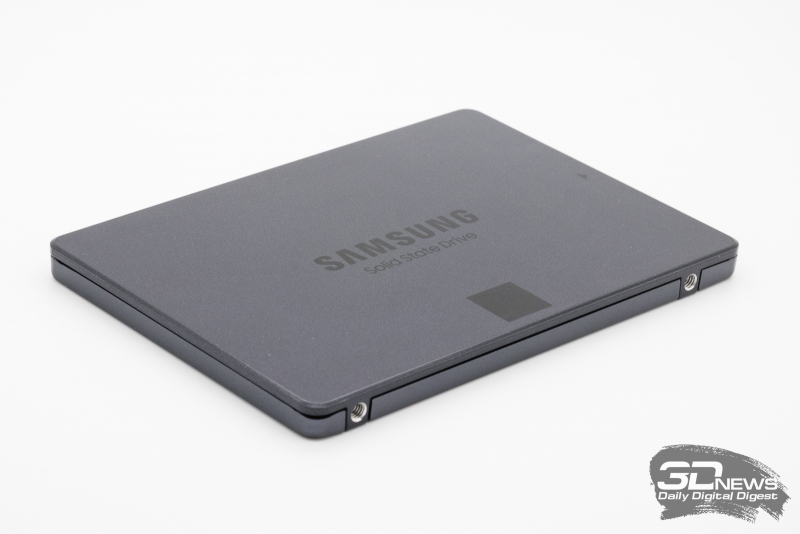
It is quite simple to describe the design of the Samsung 870 QVO in a nutshell. In fact, this is the same 870 EVO, but in which the TLC memory was replaced by a denser, cheaper and slower QLC 3D V-NAND. And that’s understandably why the 870 QVO is better than any other QLC drive. Here, an array of flash memory is driven by a productive Samsung MKX controller, which is reinforced with a gigabyte of LPDDR4 to buffer calls to the address translation table.
| Samsung 870 QVO | Stated | Actually |
|---|---|---|
| Capacity | 1000 GB | 932 GiB |
| Controller | Samsung MKX | Samsung MKX |
| DRAM | 1 GB LPDDR4 | 1 GB LPDDR4 SDRAM |
| NAND | Samsung QLC V-NAND | Samsung 96-layer 1024-Gbps QLC 3D V-NAND |
The advanced configuration of the Samsung 870 QVO is firmly fixed in the specifications, so potential buyers of the 870 QVO cannot expect any unpleasant surprises – the DRAM buffer and controller as in the 870 EVO will not go anywhere.

Thanks to the powerful hardware, the manufacturer has earned the right to credit the 870 QVO with high performance indicators that make it the most productive SSD with QLC memory on the market.
| Samsung 870 QVO 1000 GB | |
|---|---|
| Linear read speed | 560 MB / s |
| Linear recording speed | 530 MB / s |
| Random read speed | 98 IOPS |
| Random write speed | 88 IOPS |
| Recording resource | 300 TB |
| Mean time between failures | 1,5 million hours |
| Warranty | 3 years |
Moreover, it is easy to see that the performance specifications of the Samsung 870 QVO coincide with those of the obviously higher class drive, the 870 EVO.
Surprisingly, this state of affairs is confirmed by the CrystalDiskMark test. Loses 870 QVO only in small-block read speed in the absence of a request queue. And this is natural: QLC memory really has higher latencies.
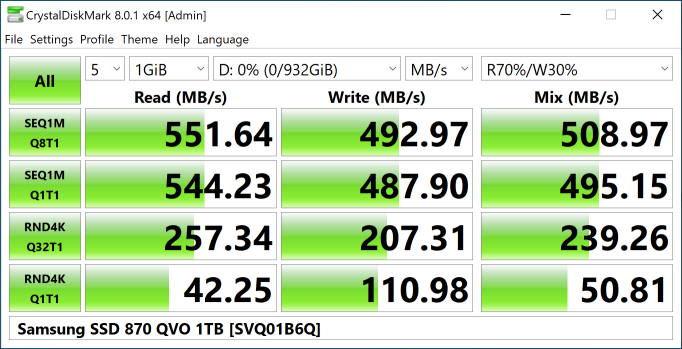
But the high performance here is largely due to the SLC caching technology, which Samsung calls TurboWrite. Moreover, in the case of a QLC drive, its role is decisive: if you look at how the linear speed of continuous write looks like in the 870 QVO, it becomes clear that in its native four-bit mode, the flash memory array will be able to receive data only at a speed of about 80 MB / from.
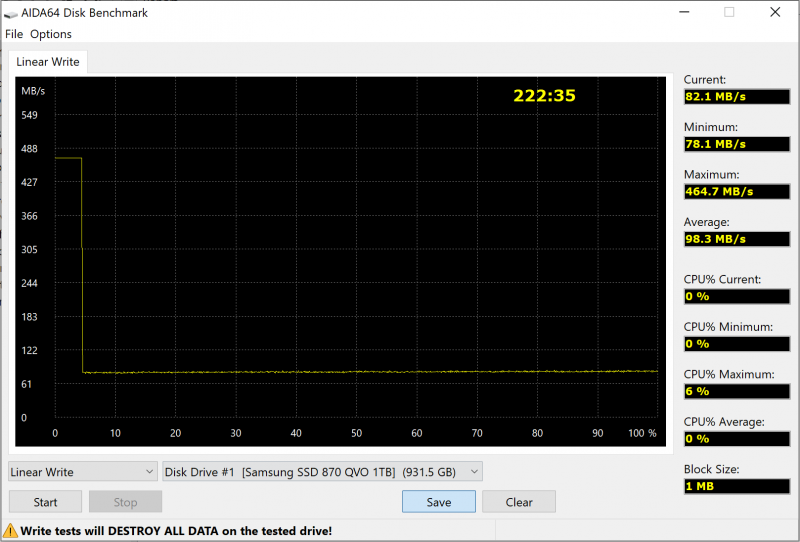
Therefore, under prolonged or intense loads, the 870 QVO will be inferior to higher-end drives. But it is still significantly better than any other QLC drive, since there are no other QLC SSDs with DRAM buffers on the market.
But the Samsung 870 QVO cannot compete with TLC offerings. This is primarily due to memory endurance. That is why the warranty for this drive is limited to three, not five years, and the resource is limited to three hundred rewriting cycles.
⇡ # Seagate Barracuda 120
Seagate entered the consumer storage market much later than its main competitors. In addition, she was unable to establish her own development and production of solid-state drives, therefore, at the moment, despite the huge experience in the HDD market, as an SSD manufacturer, she can only be considered a second or third tier player who is exclusively engaged in rebranding and selling third-party products for its own brand.

Seagate has chosen Phison as a partner, and all drives sold under the Barracuda or Firecuda names are nothing more than redesigned reference platforms from that developer. However, this does not mean that Seagate has nothing to please those who need a high-quality and fast SATA SSD. For the Barracuda 120, Seagate has opted for the highest performance SATA Phison platform, so it’s a decent drive by today’s standards. More specifically, this SSD model is based on the eight-channel Phison PS3112-S12 platform, which is quite rare, but is quite capable of competing with the Samsung 870 EVO.
| Seagate Barracuda 120 | Stated | Actually |
|---|---|---|
| Capacity | 1 TB | 932 GiB |
| Controller | — | Phison PS3112-S12 |
| DRAM | — | 256 MB DDR3 SDRAM |
| NAND | TLC 3D NAND | Kioxia 96-layer 256Gb TLC 3D NAND |
Curiously, Seagate never officially claims that the Barracuda 120 is a Phison PS3112-S12 drive. However, judging by the fact that for this SSD the controller is specially re-labeled in Seagate STXZA01F5578, cooperation with Phison is long-term and the company does not intend to switch to any other platform. And this is good news, because there are almost no other such drives on the market.
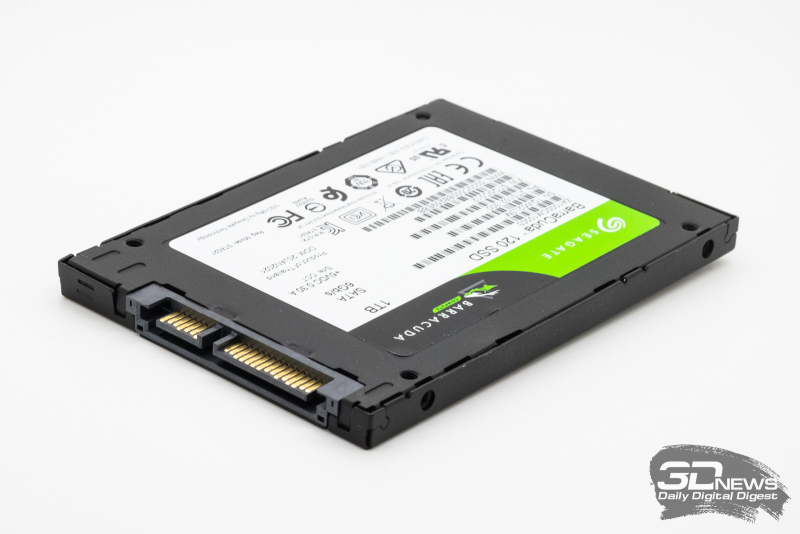
Along with a powerful eight-channel controller, the Barracuda 120 comes with Kioxia BiSC4 256-bit memory, which promises to help you achieve good performance. It has low latency, plus it has 256-gigabit crystals, which allows you to get a higher level of parallelism compared to most other SSDs. Somewhat alarming is the DRAM buffer cut to 120 MB, but in the specifications Seagate promises that the Barracuda XNUMX belongs to the flagship SATA products.
| Seagate Barracuda 120 1 TB | |
|---|---|
| Linear read speed | 560 MB / s |
| Linear recording speed | 540 MB / s |
| Random read speed | 90 IOPS |
| Random write speed | 90 IOPS |
| Recording resource | 600 TB |
| Mean time between failures | 1,8 million hours |
| Warranty | 5 years |
According to the passport specifications, the Barracuda 120 should fall into the subgroup of the most productive SATA SSDs.
The results of the synthetic benchmark CrystalDiskMark fully confirm this. In fact, the Barracuda 120 lags behind the leaders only in the speed of random reads without a request queue, but this flaw is compensated by the advantage in performance of mixed operations.
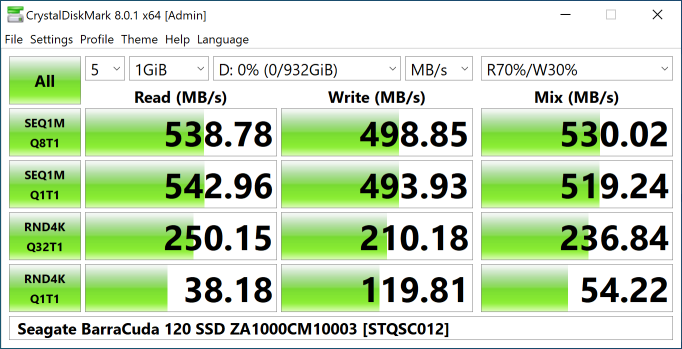
However, Phison controllers use SLC read caching to improve performance in synthetic tests. Therefore, under real loads, the performance of small-block reading may turn out to be even lower in comparison with the value shown in the CrystalDiskMark screenshot.
But the high degree of parallelism of the flash memory array makes SLC caching completely unnecessary for write operations. The entire volume of a terabyte Seagate Barracuda 120 can be filled up in 69 minutes, and no performance drop can be seen when the SLC cache is exhausted.

The Barracuda 120 is one of the best SATA SSDs under the warranty. Its term is 5 years, during this time the drive is allowed to write 600 TB of data – a typical amount of information for solutions based on modern TLC memory. There is only one problem with the Barracuda 120 – Seagate for some reason stopped deliveries of this promising model, and it is rapidly disappearing from store shelves.
⇡ # Seagate Barracuda Q1
It looks like the high performance SATA drive Seagate Barracuda 120 is leaving the market and is being replaced by another barracuda – the Barracuda Q1. However, such a replacement is not at all equivalent, because the Barracuda Q1 is a drive that does not claim the laurels of a flagship, but, on the contrary, targets the lower price segment.
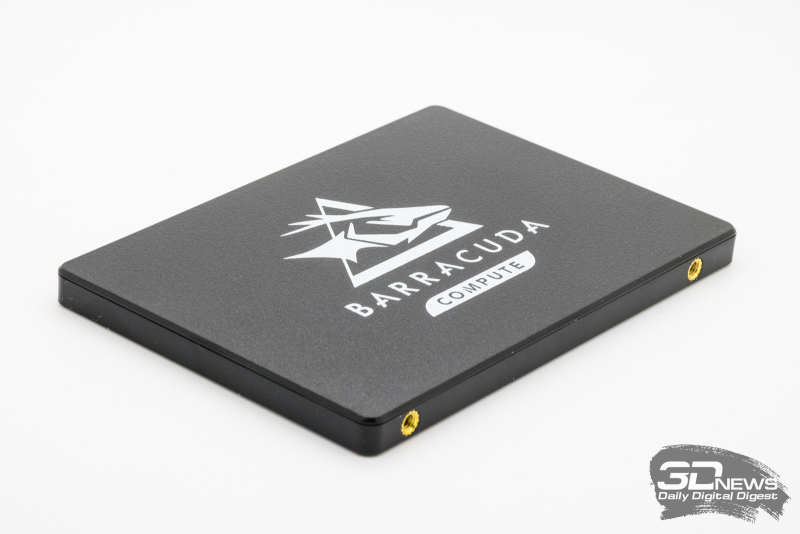
Seagate continued its partnership with Taiwanese manufacturer Phison on the Barracuda Q1 and is a branded version of the Phison PS3111-S11 reference platform. Moreover, in its weakest form – complete with QLC 3D NAND, which is clearly stated in the specifications. Thus, the Barracuda Q1 should be compared not with the Samsung 870 EVO, but with the Kingston A400, which is clearly indicated by its low price.
| Seagate Barracuda Q1 | Stated | Actually |
|---|---|---|
| Capacity | 960 GB | 894 GiB |
| Controller | — | Phison PS3111-S11 |
| DRAM | — | No |
| NAND | QLC 3D NAND | Intel 64-layer 1024-Gbps QLC 3D NAND |
The Barracuda Q1 hardware platform is not specified in the specifications, but, as in the case of the Barracuda 120, the Phison PS3111-S11 controller is re-labeled STXZA01F5578 here, so it is unlikely to be replaced in the foreseeable future. This means that the Barracuda Q1 will remain in the group of “lagging behind” – you won’t get far with a bufferless dual-channel controller.
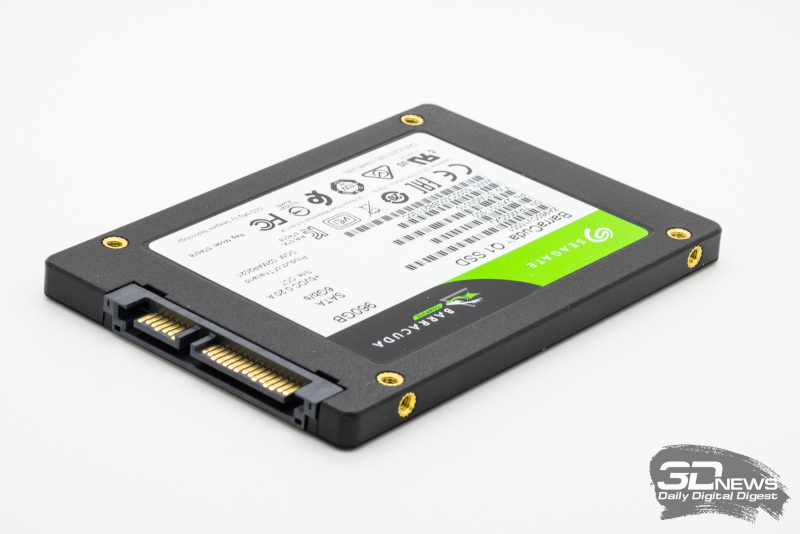
In order not to shock the user with low speed characteristics from the start, Seagate simply did not write the performance of the Barracuda Q1 on random operations in the specification.
| Seagate Barracuda Q1 960 GB | |
|---|---|
| Linear read speed | 550 MB / s |
| Linear recording speed | 500 MB / s |
| Random read speed | — |
| Random write speed | — |
| Recording resource | 280 TB |
| Mean time between failures | 1,8 million hours |
| Warranty | 3 years |
Although if these characteristics were specified, nothing terrible would have happened. As testing in CrystalDiskMark shows, on random small-block operations with a deep queue of requests, it is capable of delivering about 40-50 thousand IOPS.
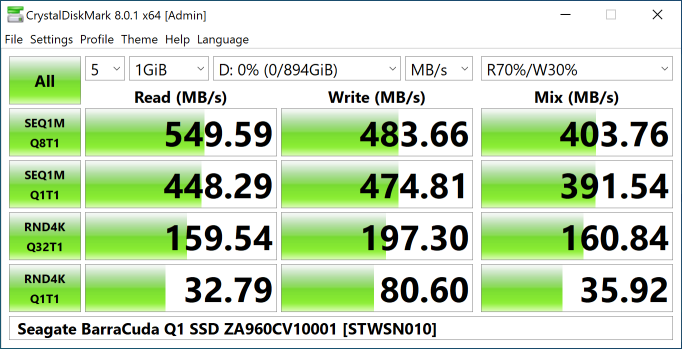
Overall, the CrystalDiskMark results don’t look particularly bad. The Phison PS3111-S11 platform, even in combination with QLC 3D NAND, is able to hide its shortcomings behind SLC caching, which works both for writing and for reading. Therefore, in light workloads on small amounts of data, the Barracuda Q1 can demonstrate quite acceptable performance.
However, if, for example, you look at what write speed will be observed when the entire volume of the SSD is sequentially filled, then you can be unpleasantly surprised. A full terabyte Barracuda Q1 takes about seven hours to complete, while a Barracuda 120 takes only 69 minutes to complete.
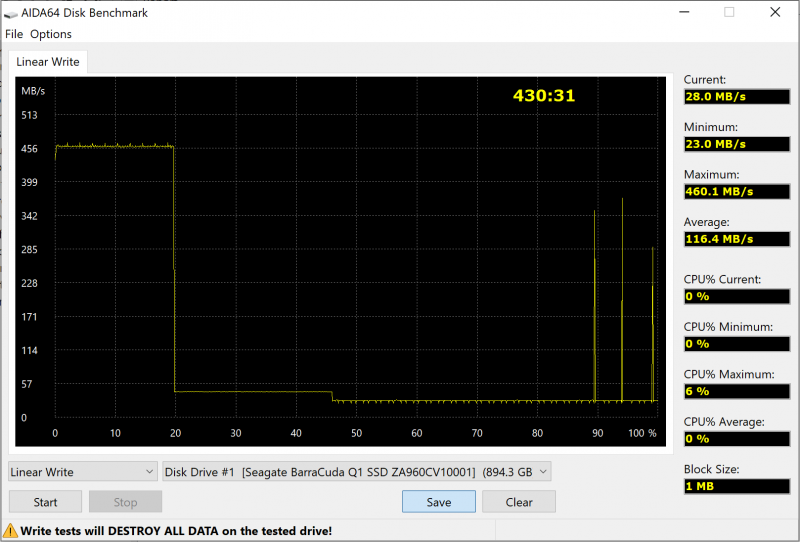
Approximately the same drop in speed is observed when reading – accessing large amounts of data makes the controller, devoid of a DRAM buffer, literally choke on requests. The reliability indicators of the Barracuda 120 do not inspire optimism either – according to the data from the specification, it is designed for only 280 rewrites during its life.
⇡ # Transcend SSD230S
Transcend’s SSD230S is another long-lived consumer SATA SSD. This model first appeared in 2017, and it has successfully survived to the present moment without any special losses. It is worth giving credit to Transcend: despite all the changes that have taken place, it did not compromise on specifications and today’s SSD230S is at least as good as the SSD versions that were sold under the same name four years ago.
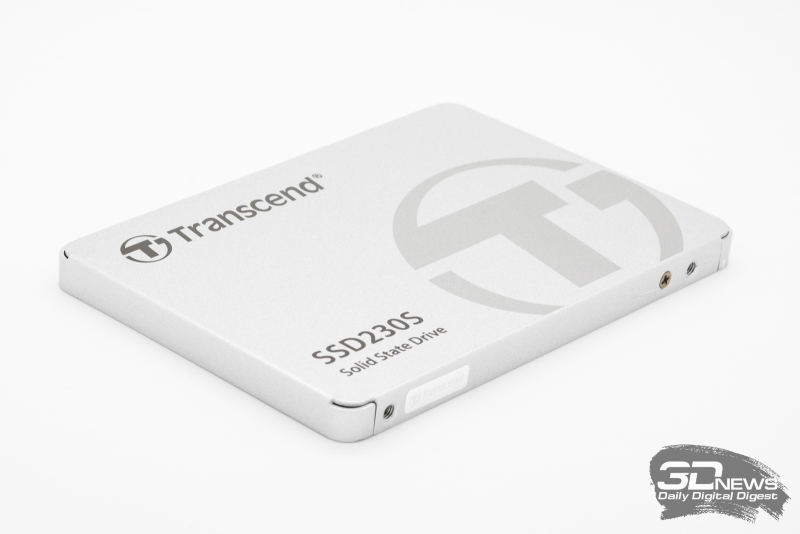
As before, the SSD230S is based on a four-channel SMI SM2258 controller equipped with a gigabyte DDR3 SDRAM buffer to store a copy of the address translation table. The flash memory used has naturally changed over the years, but it is still TLC 3D NAND. The supplier of flash memory for the test instance of SSD230S was SanDisk, the chips used are BiSC3, that is, we are talking about memory with a 64-layer design.
| Transcend SSD230S | Stated | Actually |
|---|---|---|
| Capacity | 1 TB | 954 GiB |
| Controller | — | SMI SM2258 |
| DRAM | — | 1024 MB DDR3 SDRAM |
| NAND | 3D NAND | SanDisk 64-layer 512Gb TLC 3D NAND |
Transcend itself does not specify in the specifications either the type of memory used or the name of the controller, which leaves the manufacturer room for maneuver. But judging by the fact that the configuration has remained unchanged for several years, no trick can be expected anymore. It looks like Transcend intends to keep the SSD230S as a solid mid-range solution, similar to the ADATA Ultimate SU800.
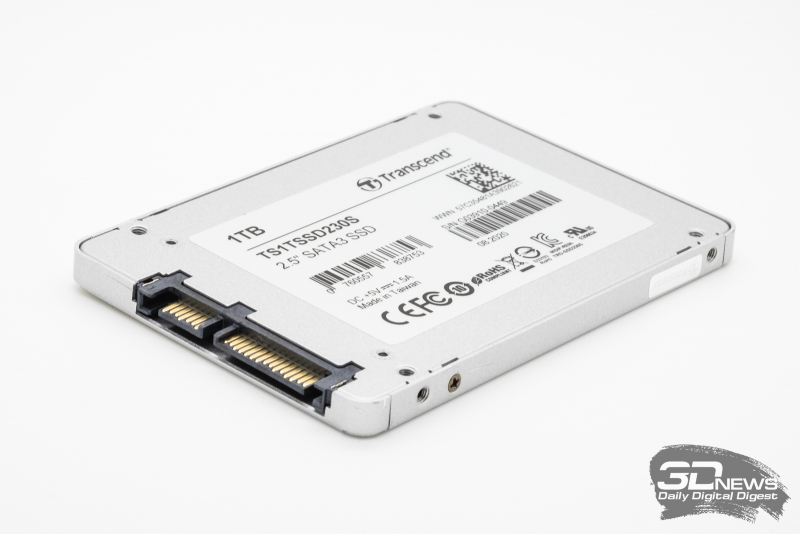
The numerical specifications of the Transcend SSD230S are as follows.
| Transcend SSD230S 1 TB | |
|---|---|
| Linear read speed | 560 MB / s |
| Linear recording speed | 500 MB / s |
| Random read speed | 85 IOPS |
| Random write speed | 85 IOPS |
| Recording resource | 560 TB |
| Mean time between failures | 2,0 million hours |
| Warranty | 5 years |
Performance figures are quite common for mid-range drives based on three-bit flash memory. The use of 230 Gbit NAND devices in the SSD512S allows you to get a high degree of parallelism in the flash memory array of a terabyte drive, which is sufficient for the SATA interface bandwidth to be full during linear operations both when accessing the SLC cache and when writing directly to TLC memory.
In the CrystalDiskMark benchmark, the Transcend SSD230S performs similarly to other drives based on SMI SM2258 / SM2259 controllers, although using SanDisk memory rather than Micron or Intel provides a slight advantage.
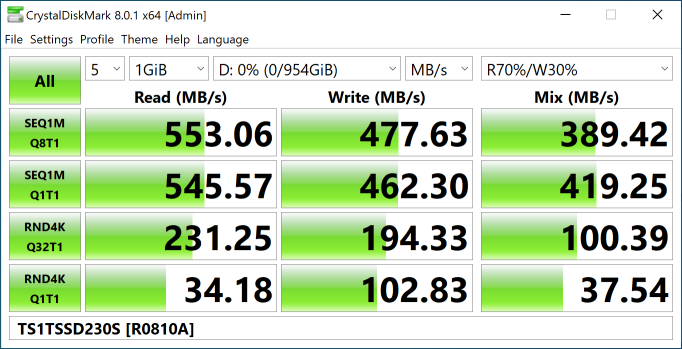
Dynamic SLC caching, implemented in the Transcend SSD230S, practically does not manifest itself in any way during continuous linear recording to the full volume of the drive.
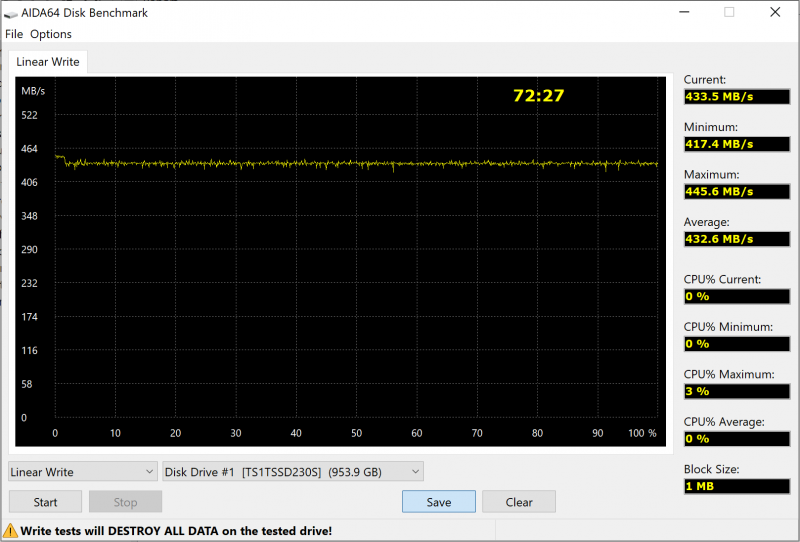
At the same time, the effect of the SLC cache is noticeable during small-block reading – caching overestimates the performance of synthetic tests, but in reality, the speed of reading 4-KB blocks without a queue of requests occurs with a performance of not 40, but about 30 MB / s. What this translates into in real scenarios will be seen below. But in any case, SSD230S noticeably outperforms drives without a DRAM buffer, of which there have been a lot of SATA drives lately.
⇡ # Transcend SSD220Q
Along with the SSD230S, Transcend also has an entry-level option – the SSD220Q. The manufacturer openly says that such a drive is based on QLC memory, but for our part we can add that, among other things, the SSD220Q uses a bufferless design.
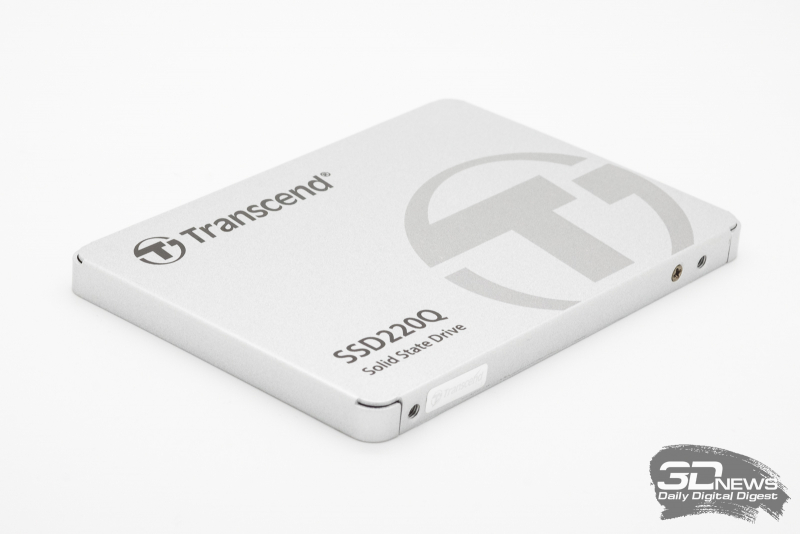
Thus, the Transcend SSD220Q is a set of compromises: in it, the manufacturer saved on everything at once. Unfortunately, this did not make the SSD220Q as affordable an offering as, for example, the Kingston A400, which advocates a similar approach to architecture. However, in fairness, it should be noted that the Transcend SSD220Q is built on the SMI SM2259XT controller, which works with flash memory not in two, but in four channels. This can be beneficial in some use cases, as the four-channel design provides higher linear speeds.
| Transcend SSD220Q | Stated | Actually |
|---|---|---|
| Capacity | 1 TB | 932 GiB |
| Controller | — | SMI SM2259XT |
| DRAM | — | No |
| NAND | — | Micron 96-layer 1024-Gbps QLC 3D NAND |
There are many drives similar to the filling of the Transcend SSD220Q. The most notable of these is the Crucial BX500. Therefore, there is no reason to expect any unexpected performance from the SSD220Q. Here we are dealing with an entry-level drive, and these are the characteristics declared for it.
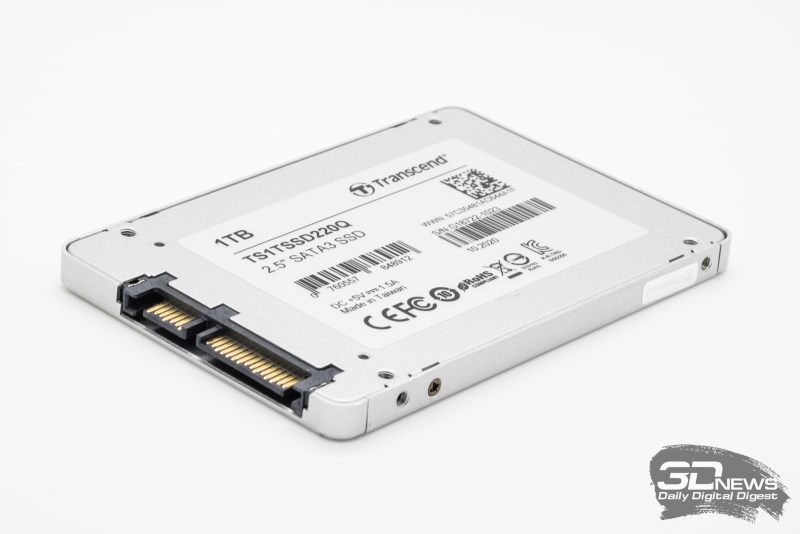
Unlike competitors, Transcend did not hesitate to describe in detail all the performance characteristics, including the performance of small-block operations.
| Transcend SSD220Q 1 TB | |
|---|---|
| Linear read speed | 550 MB / s |
| Linear recording speed | 500 MB / s |
| Random read speed | 57 IOPS |
| Random write speed | 79 IOPS |
| Recording resource | 200 TB |
| Mean time between failures | 2,0 million hours |
| Warranty | 3 years |
However, in CrystalDiskMark the values are slightly different. A real synthetic test gives clearly lower readings when writing – both with sequential and random. But this difference can be easily attributed to the fact that in our case the measurements were performed on a system with an AMD processor, where the chipset SATA controller is slower than in systems based on Intel components.
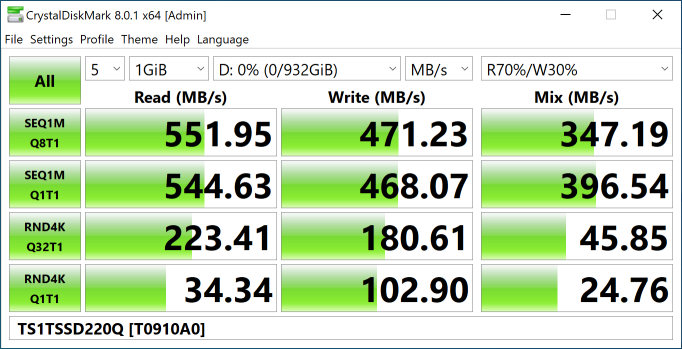
Attention is also drawn to the rather low rates of random mixed operations. This is how the SMI SM2259XT controller manifests itself – it has some problem with efficient processing of multidirectional command streams. Another flaw is a serious decrease in small-block read speeds with an increase in the amount of data that is being accessed. This is due to the lack of a DRAM buffer in the drive design, and one should bear in mind that the Transcend SSD220Q may slow down under intense loads.
SLC caching in SSD220Q works according to a dynamic scheme, it is it that provides the performance indicators that can be seen in the CrystalDiskMark screenshot. However, when the flash array is switched to QLC mode, performance drops dramatically. This can be clearly seen on the graph of the speed of continuous linear recording. It can drop down to 40-50 MB / s.
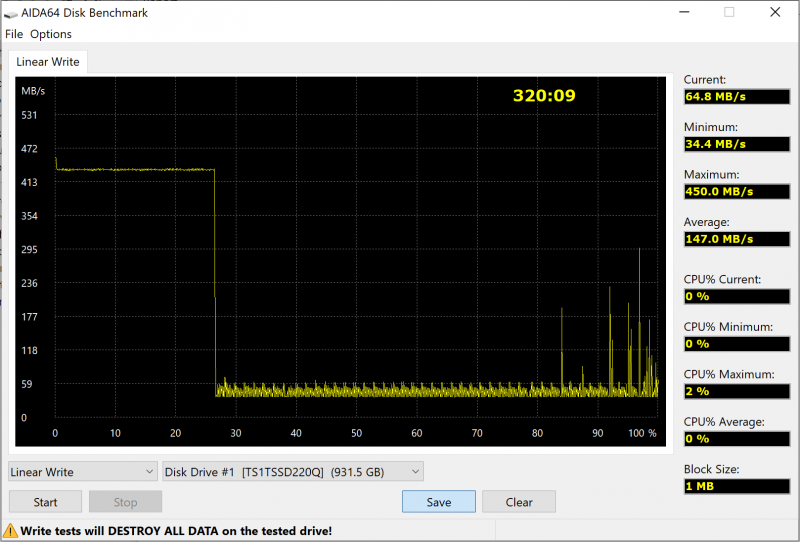
Transcend’s SSD220Q does not differ from other QLC-drives in terms of reliability. The manufacturer provides it with a three-year warranty and allows it to be completely rewritten 200 times.
⇡ # WD Blue SATA SSD
WD Blue can be safely attributed to the old-timers of the solid state drive market. This SSD first hit the market in 2016 after Western Digital acquired SanDisk. And since then it has remained a very relevant SATA solution of the middle class. Moreover, over the past five years, its hardware platform has not changed much. Once settled on the Marvell 88SS1074 controller, Western Digital has stubbornly pursued its choice. This even led to the fact that WD Blue was the only SSD on the market using this controller.
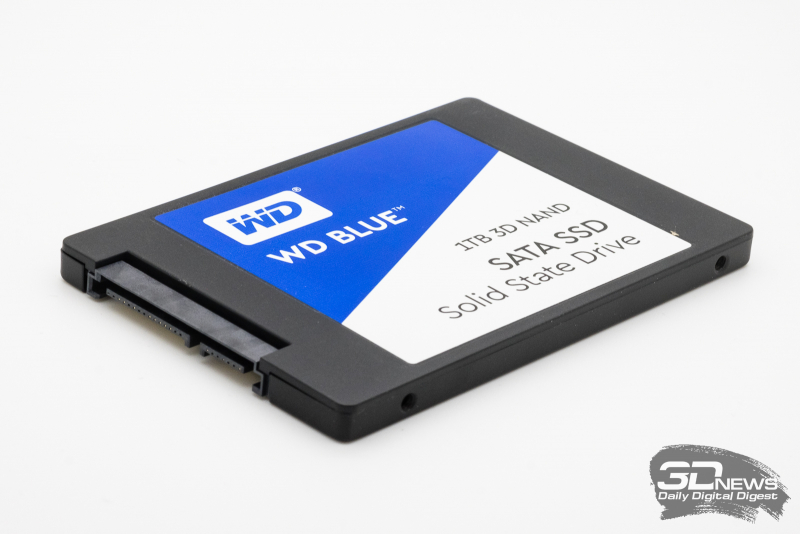
However, the configuration of WD Blue still changes slightly. This applies to the used flash memory. This drive began with planar TLC memory, but in current versions you can find 96-layer TLC 3D NAND manufactured by SanDisk. However, this is even better, since with each new generation BiCS memory becomes faster, and it is logical to expect that WD Blue’s performance will gradually grow along with this.
| WD Blue SATA SSD | Stated | Actually |
|---|---|---|
| Capacity | 1 TB | 954 GiB |
| Controller | — | Marvell 88SS1074 |
| DRAM | — | 512 MB DDR3 SDRAM |
| NAND | — | SanDisk 96-layer 512Gb TLC 3D NAND |
It is quite indicative that the official specifications do not specify the WD Blue configuration at all. But that doesn’t stop the manufacturer from sticking to the original platform – that’s what caring for its reputation means.
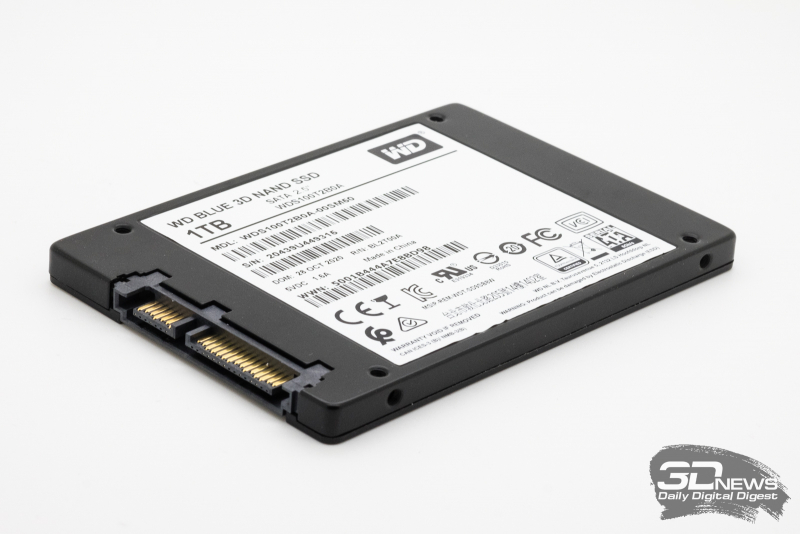
But the performance characteristics for their “blue” drive Western Digital described very carefully.
| WD Blue SATA SSD 1 TB | |
|---|---|
| Linear read speed | 560 MB / s |
| Linear recording speed | 530 MB / s |
| Random read speed | 95 IOPS |
| Random write speed | 84 IOPS |
| Recording resource | 400 TB |
| Mean time between failures | 1,75 million hours |
| Warranty | 5 years |
The Marvell 88SS1074 controller is a mid-range (in a good way) solution. It operates on an array of flash memory across four channels and uses 512MB of DRAM to buffer address translation table calls. In combination with fast TLC 3D NAND, this allows you to achieve good performance, which is reflected in the specification.
The measurements in CrystalDiskMark only confirm what has been said. Compared to the Samsung 870 EVO, it is still a little slower, but overall, the speeds in the synthetic benchmark are quite decent. The main thing is that the drive does not give in to mixed loads.

Naturally, WD Blue has SLC caching technology that works on a static basis. However, the small amount of memory allocated for the cache is not a critical drawback. The parallelism of the flash memory array is quite enough so that the linear write speed does not drop when the SLC cache is exhausted.
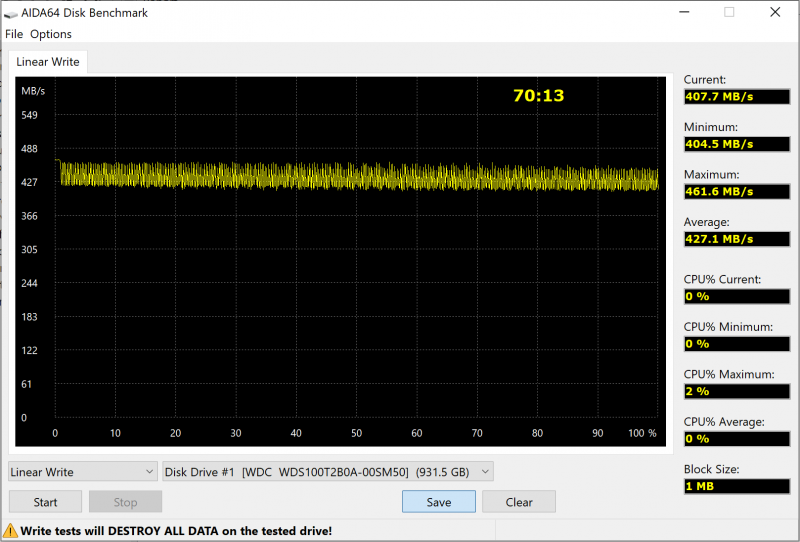
Therefore, the only effect that caching gives in this case is to accelerate the speed of small-block reading of the files just written. When accessing information that has been written to the SSD not just that, the performance of random reading in 4-KB blocks out of the queue of requests will not be 41 KB / s, but a faster 33 KB / s.
And one more fact about WD Blue that should be borne in mind: despite the fact that it is based on TLC 3D NAND, under the terms of the warranty, the manufacturer only allows its capacity to be overwritten 400 times. Therefore, the declared endurance of this SSD is not very high.
⇡ # WD Green SATA SSD
Western Digital’s SSDs have always stood for originality. And WD Green is another drive alongside Blue that is second to none. Initially, SMI controllers were used for it, but later Western Digital switched to an internally developed chip. True, for users this has become more of a minus than a plus, since the proprietary controller is an extremely weak solution, practically incapable of working with mixed or multi-threaded operations.
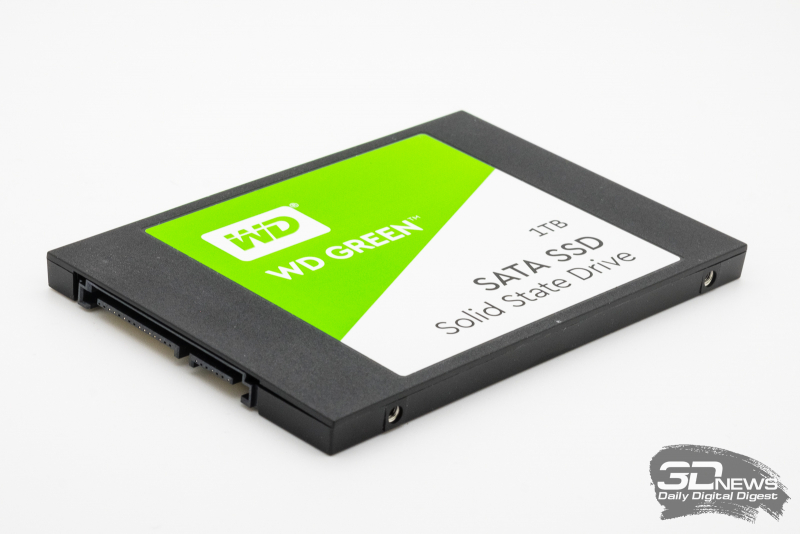
In terms of positioning, WD Green is an entry-level solution, in stores this drive is offered among the cheapest terabyte SSDs. However, unlike its neighbors in the price lists, it is based not on four-bit memory, but on a full-fledged TLC 3D NAND. While this is not in the specs, to date Western Digital has not been seen attempting to switch to QLC memory, which is Green’s trump card. However, the bufferless design and controller limitations create an unbridgeable chasm between the performance of the WD Green and the more expensive WD Blue.
| WD Green SATA SSD | Stated | Actually |
|---|---|---|
| Capacity | 1 TB | 932 GiB |
| Controller | — | SanDisk 20-82-00469-2 |
| DRAM | — | No |
| NAND | — | SanDisk 96-layer 512Gb TLC 3D NAND |
Nothing definite is known about the architecture of the SanDisk 20-82-00469-2 controller, except that it does not provide a DRAM interface. However, from experience we can say that this is one of the worst options that can be found in modern SATA SSDs. Despite the fact that WD Green is a TLC 3D NAND based drive, it almost always loses in speed to cheap QLC rivals.

Actually, this is exactly what is reflected in the official specifications. Performance with random operations Western Digital decided not to report, but even the declared speed with linear write is able to clearly express what to expect from such an SSD.
| WD Green SATA SSD 1 TB | |
|---|---|
| Linear read speed | 545 MB / s |
| Linear recording speed | 80 MB / s |
| Random read speed | — |
| Random write speed | — |
| Recording resource | — |
| Mean time between failures | 1,0 million hours |
| Warranty | 3 years |
The random write performance of the WD Green was hidden for a reason. The controller of this drive simply does not know how to work with request queues, processing all requests strictly sequentially, like a USB flash drive.
This can be clearly seen even in the synthetic benchmark CrystalDiskMark. Low performance indicators in it are obtained not only in tests with a deep queue of requests, but also during mixed operations.

All this looks rather sad, especially against the background of the fact that from 2016 to 2018, when WD Green was based on the SMI SM2258XT platform, its characteristics were much better.
For the sake of fairness, it should be noted that during normal linear operations, WD Green does not look so sad thanks to SLC caching and fast TLC memory. For example, the full capacity of a terabyte modification using continuous sequential write can be filled with data in an hour and a half – four times faster than drives based on QLC 3D NAND.

However, the constant speed spread after 100% filling of the minimum static SLC cache indicates another problem – the inability of the WD Green controller to write directly to the TLC memory. All operations are carried out exclusively through the cache, which destabilizes the process if there is no free space in the cache.
Curiously, Western Digital does not specify in the WD Green specifications what kind of rewriting capacity this drive is designed for. On the one hand, this leaves the manufacturer room for replacing TLC memory with a less hardy QLC, and on the other hand, it allows the installation of flash memory chips of completely different quality in SSDs. In other words, WD Green is a collection of tradeoffs that is hard to make any reasonable arguments for beyond affordable cost.
⇡ # Classes of tested drives (table)
In this place in our benchmark reports, we usually provide a summary table of the characteristics of the drives participating in them, indicating the hardware platforms and the declared performance indicators. However, this time we will restrict ourselves to a slightly different table with other data that is more useful in our opinion. In it, we will distribute drives into classes based on the type of memory used and the presence or absence of a DRAM buffer, as well as designate which SSDs have a fixed hardware configuration, and which ones can change the filling due to the manufacturer’s desire to optimize the cost of the model.
In this case, we do not consider changing the manufacturer of the flash memory to be a significant change in the configuration. A critical change in the hardware configuration is considered only to replace the TLC memory with QLC or vice versa (yes, this also happens), as well as the replacement of the base controller. To concretize SSD configurations with a stable filling, the name of the controller used is indicated in brackets.
| Memory Type | DRAM buffer | Stable configuration | Variable configuration |
| MLC 3D NAND | There is | Samsung 860 PRO (Samsung MJX) | |
| TLC 3D NAND | There is | ADATA Ultimate SU800 (SMI SM2258) Crucial MX500 (SMI SM2259) GoodRAM IRDM Pro Gen.2 (Phison PS3112-S12) HP S700 Pro (SMI SM2258) Kingston KC600 (SMI SM2259) Samsung 870 EVO (Samsung MKX) Samsung 860 EVO (Samsung MJX) Seagate Barracuda 120 (Phison PS3112-S12) Transcend SSD230S (SMI SM2258) WD Blue SATA SSD (Marvell 88SS1074) |
|
| No | HP S750 (SMI SM2259XT) WD Green SATA SSD (Sandisk 20-82-00469-2) |
ADATA ULTIMATE SU750 ADATA ULTIMATE SU650 ADATA ULTIMATE SU630 Patriot P210 |
|
| QLC 3D NAND | There is | Samsung 870 QVO (Samsung MKX) | |
| No | Seagate Barracuda Q1 (Phison PS3111-S11) Transcend SSD220Q (SMI SM2259XT) |
ADATA ULTIMATE SU720 Crucial BX500 Kingston A400 Patriot burst Patriot burst elite |
⇡ # Description of the test system and testing methodology
Tests conducted on AMD platform with Ryzen 7 5800X processor and X570 motherboard. The drives under study were connected to the SATA controller built into the chipset. Test system configuration:
- Processor: AMD Ryzen 7 5800X (Vermeer, 8 cores + SMT, 3,8-4,7 GHz, 32 MB L3);
- CPU cooler: Noctua NH-D15;
- Motherboard: ASUS ROG Crosshair VIII Hero (Socket AM4, AMD X570);
- Memory: 2×16 GB DDR4-3600 SDRAM, 16-18-18-38 (Crucial Ballistix RGB BL2K16G36C16U4BL).
- Video card: NVIDIA GeForce RTX 3080 Founders Edition (GA102, 1440-1710 / 19000 MHz, 10 GB GDDR6X 320-bit).
- Power supply: Thermaltake Toughpower DPS G RGB 1000W Titanium (80 Plus Titanium, 1000W).
The following benchmarks were used to measure SSD performance:
- CrystalDiskMark 8.0.0… This benchmark is included in the methodology because it was able to become the industry standard for determining the characteristics of SSDs. In our case, it is used to determine the peak performance of drives in various modes.
- Iometer 1.1.0… A professional benchmark suite that measures realistic SSD performance under common refined workloads.
- PCMark 10 Storage Benchmark… A benchmark application that measures the performance of a disk subsystem while simulating typical user experience. Three scenarios are used – basic (working in applications and normal interaction with the file system), lightweight (modeling the system disk) and file trash (modeling file storage).
- 3DNews own tests… Measuring the speed of copying files using the Robocopy utility, the speed of archiving and unzipping files with the 7-zip archiver, and the performance of disk operations when starting Far Cry 4, or when starting a series of large applications, including Microsoft Word, Adobe Photoshop and Premiere Pro.
⇡ # Full list of test participants
- ADATA Ultimate SU630 960GB (ASU630SS-960GQ-R, firmware V8X02c08);
- ADATA Ultimate SU650 960GB (ASU650SS-960GT-R, firmware V8X01c89);
- ADATA Ultimate SU720 1TB (ASU720SS-1T-C, firmware N200409a);
- ADATA Ultimate SU750 1TB (ASU750SS-1TT-C, firmware XA004R07);
- ADATA Ultimate SU800 1TB (ASU800SS-1TT-C, firmware R0918B);
- Crucial BX500 1TB (CT1000BX500SSD1, firmware M6CR030);
- Crucial MX500 1TB (CT1000MX500SSD1, firmware M3CR033);
- HP SSD S700 Pro 1TB (2LU81AA, firmware R0201B);
- HP SSD S750 1TB (16L54AA, firmware T0508B1);
- Goodram IRDM Pro Gen.2 1TB (IRP-SSDPR-S25C-01T, firmware SCFM22.3);
- Kingston A400 960GB (SA400S37 / 960G, firmware SBFKK1C3);
- Kingston KC600 1TB (SKC600 / 1024G, firmware S4500105);
- Patriot Burst 960GB (PBU960GS25SSDR, firmware SBFMKA.3);
- Patriot Burst Elite 960GB (PBE960GS25SSDR, firmware S1128B0);
- Patriot P210 1TB (P210S1TB25, firmware T0929A0);
- Samsung SSD 860 EVO 1TB (MZ-76E1T0BW, firmware RVT04B6Q);
- Samsung SSD 860 PRO 1TB (MZ-76P1T0BW, firmware RVM01B6Q);
- Samsung SSD 870 EVO 1TB (MZ-77E1T0BW, firmware SVT01B6Q);
- Samsung SSD 870 QVO 1TB (MZ-77Q1T0BW, firmware SVQ01B6Q);
- Seagate BarraCuda 120 1TB (ZA1000CM10003, firmware STQSC012);
- Seagate BarraCuda Q1 960GB (ZA960CV10001, firmware STWSN010);
- Transcend SSD220Q 1TB (TS1TSSD220Q, firmware T0910A0);
- Transcend SSD230S 1TB (TS1TSSD230S, firmware R0810A);
- WD Blue SATA SSD 1TB (WDS100T2B0A-00SM50, firmware 415000WD);
- WD Green SATA SSD 1TB (WDS100T2G0A-00JH30, firmware UH450400).
⇡ # Linear performance

When measuring linear read speed, drives are divided into two subgroups: those with performance close to the bandwidth of the SATA interface, and drives that do not provide 500 MB / s. At first glance, the watershed is in the type of memory used: drives with QLC 3D NAND are noticeably slower than their TLC counterparts. But there are also exceptions. So, in the top subgroup are some QLC drives with the SM2259XT controller – Transcend SSD220Q, Patriot P210, HP S750 and Crucial BX500; and the lower subgroup includes the WD Green bufferless TLC model and various versions of low-end ADATA drives, where Realtek controllers are used.

The sequential write speed is primarily affected by the speed of the cache memory array and the efficiency of SLC caching algorithms. Therefore, in the end, those SSDs that have an eight-channel array of NAND devices are in the top positions here. Next come drives with a four-channel array, then – with a two-channel array, and so on. However, there are also surprises. For example, the ADATA Ultimate SU720, which uses QLC memory and a Maxiotek controller, climbed relatively high. Some QLC models based on the SMI SM2259XT controller also performed well. However, you need to understand that simple linear recording is the lightest load for an SSD.

However, with a mixed linear load, the situation is not very different. At the top positions are Samsung drives and a pair of SSDs from Seagate and Goodram, based on the Phison PS3112-S12 controller, that is, just those models based on the eight-channel TLC 3D NAND array. SSDs based on three-bit memory, where the SMI SM2258 / SM2259 controller is used (for example, Kingston KC600, HP SSD S700 Pro or Crucial MX500) perform slightly worse and take the position of solid middlings. If we talk about the most budget options that perform best under a linear mixed load, then first of all we should mention Kingston A400, Patriot P210 and Transcend SSD220Q, which show good performance thanks to a spacious and fast SLC cache.
⇡ # Performance of random operations

When measuring the speed of small-block reading with small request queues, that is, with such a load as is typical for traditional desktop PCs, Samsung 860 PRO, the only drive with MLC memory remaining on the market, comes out on top by a wide margin. If you look at the results shown by TLC-drives, then among them the best positions are taken by those SSDs that use the most powerful controllers. These are Samsung 870 EVO, Kingston KC600, Goodram IRDM Pro Gen.2 and Seagate Barracuda 120. Among budget solutions using a bufferless design, it is worth noting the good performance of Patriot P210 and HP SSD S750, although in general it must be admitted that the absence of DRAM buffer deals a serious blow to the speed of serving small-block reads. If at the same time the SSD uses QLC memory, then the performance is even lower.

On the graph of the random write speed in 4 KB blocks, the drives are lined up in a clearly visible ladder in terms of the number of channels in the controllers they use. At the same time, the difference in the results of the productive and budget models can be quite serious. Thus, drives built on bufferless platforms are at least twice as short as their “full-fledged” brothers.

SATA SSD performance is even more noticeable when it comes to serving bi-directional small block operations. But the leaders remain the same. A group of Samsung, Goodram IRDM Pro Gen.2, and Seagate Barracuda 120 drives are firmly entrenched at the top of this chart as well. Among the bufferless drives, ADATA’s SSDs, which use exotic Realtek and Maxiotek controllers, demonstrate unexpectedly good performance, but it should be borne in mind that depriving the drive of the DRAM buffer in any case leads to halving the performance of mixed small-block operations. In this sense, the bufferless design is far more evil than the use of QLC memory. The example of Samsung 870 QVO can be cited as confirmation. This QLC model, built on a powerful controller and equipped with a DRAM buffer, rises to the leading offerings without any problems.
⇡ # Performance in PCMark 10

PCMark 10, which simulates the disk load of the average personal system and measures the performance in doing so, puts SATA drives in the expected order. The top three are the favorites of any tests – Samsung 870 EVO, Goodram IRDM Pro Gen.2 and Seagate Barracuda 120. Numerous drives based on SMI SM2258 / SM2259 controllers also show themselves worthy, but they still lag behind the leaders. But among the bufferless SSDs, the ADATA Ultimate SU720 proves to be the best option, where the rare Maxiotek MAS0902 controller is currently used. If you go down to the very bottom, and set yourself the task of finding the best budget SSD on QLC memory, then attention will be attracted by solutions based on the SMI SM2259XT controller – Crucial BX500, Transcend SSD220Q and Patriot Burst Elite and the Samsung 870 QVO, which stands alone.

If we talk about which of the SATA SSD is better suited for the role of a system disk, then the layout will practically not change. The leaders in the corresponding “system” scenario PCMark 10 remain the same. The only thing that deserves a separate mention is the high result of Samsung 870 QVO, which manages to rise to fourth place and the performance of WD Green, which is rather lousy for a model with TLC memory; models.

The third PCMark10 scenario tests drives for performance when used as file storage. And the results obtained here are different from what we saw earlier. The best speed in this case is shown by Goodram IRDM Pro Gen.2 and Seagate Barracuda 120 on the Phison PS3112-S12 controller – they are quite noticeably ahead of the Samsung 870 EVO. In addition, the ADATA Ultimate SU800 and Transcend SSD230S, which are based on the SMI SM2258 chip, boast quite a decent performance. As for bufferless drives, ADATA Ultimate SU720 stands out among them, and WD Green once again demonstrates complete failure.
⇡ # Performance in real tasks



In terms of performance for file operations, the best options are again Goodram IRDM Pro Gen.3112 and Seagate Barracuda 12 drives based on the Phison PS2-S120 chip. The Samsung 870 EVO and Samsung 860 PRO are slightly worse, followed by ADATA Ultimate in performance. SU800 and Transcend SSD230S based on SMI SM2258 controller. The highest speed among bufferless SSDs is offered by Patriot P210, and among the cheapest QLC solutions are Kingston A400, Patriot Burst Elite, Transcend SSD220Q and Seagate Barracuda Q1.
In general, the results of measuring the speed of different SATA SSDs during file operations show that chasing expensive drives for such load cases is not necessary. Even some buffered QLC models can provide decent performance. However, there are SSD models that should definitely be avoided. Among the unsuccessful options are those drives that have a slow array of flash memory, and the SLC caching technology is not efficient enough, for example, due to insufficient amount of flash memory allocated for operation in accelerated one-bit mode.
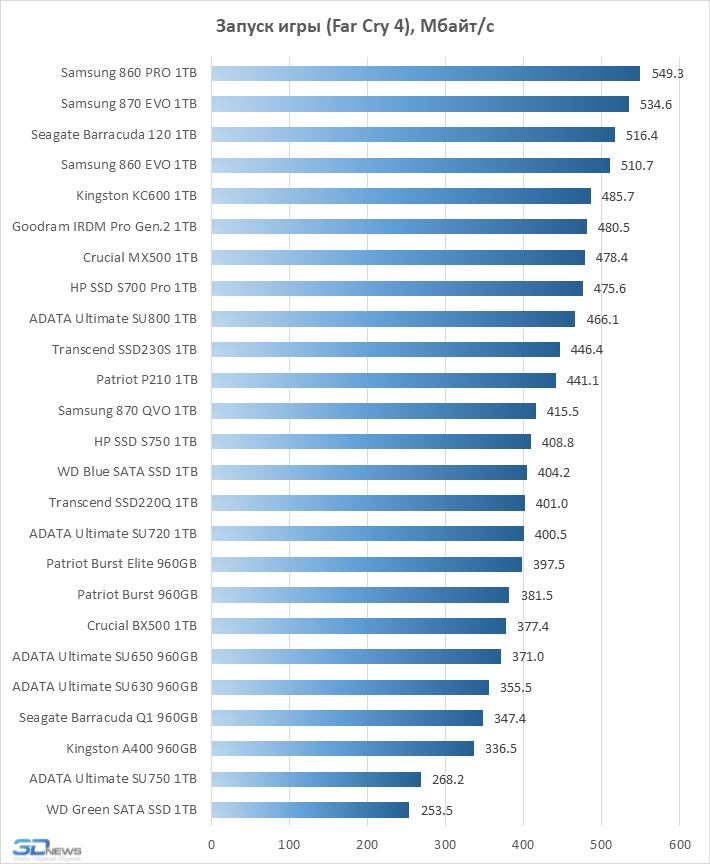
It is quite significant that the loading speed of gaming applications from various SATA SSDs can differ more than twice – this is a great argument in favor of the fact that not all SSDs are equally useful, even when it comes to SATA models. Only those SSDs that are built on TLC 3D NAND and have a DRAM buffer get into the top league under such a load. All the rest of the proposals are more or less compromises. But if you really choose from bufferless models, then it is better to pay attention to solutions based on the four-channel SMI SM2259XT controller, such as Patriot P210, HP SSD 700 Pro or Transcend SSD220Q.
At the same time, Western Digital drives cannot be successful gaming models, this applies to both Blue and Green; the entire galaxy of inexpensive ADATA drives, where Realtek controllers are used; as well as an SSD with a Phison PS3111-S11 controller, such as Kingston A400 and Seagate Barracuda Q1, which are quite successful in other scenarios.

If, however, the loading speed of the OS and working applications is chosen as a criterion for evaluating a SATA SSD, then the picture will change somewhat. In addition to the Samsung 870 EVO, Samsung 860 EVO, Samsung 860 PRO and Seagate Barracuda 120 traditionally suitable for anything at all, WD Blue, HP SSD S700 Pro and ADATA Ultimate SU800, as well as some buffer-free models, such as those the same Kingston A400 or Seagate Barracuda Q1. And such models as WD Green, ADATA Ultimate SU750 or Crucial BX500 should be avoided – their performance as system drives does not stand up to criticism.
⇡ # Conclusions
The SATA SSD market has moved from a phase of rapid development to stagnation. New efficient models with SATA interface have practically ceased to appear, old and well-proven ones are gradually disappearing from sale. As a result, if the range of SATA SSDs is replenished, then only budget models with rather mediocre or, even worse, floating characteristics. In these conditions, it becomes more and more difficult to find a worthy option for purchasing, especially if the task of choosing is complicated by the presence of rigid frameworks that determine the purchase budget.
One of the big problems of the modern SATA SSD market is that many manufacturers do not consider it necessary to maintain the constancy of the hardware filling, and resort to arbitrary replacement of controllers and flash memory in accordance with changes in market conditions. It is simply impossible to advise the products of companies that allow such shenanigans, since there is no guarantee that the customer who comes to the store will receive exactly the SSD that he originally aimed at.
Another important point that further limits the freedom of choice concerns the bufferless SSD models. There are a lot of SATA drives among them, but it should be borne in mind that any bufferless drive is obviously slower than any SSD with a DRAM buffer. Moreover, on average, the performance of such drives, according to the test data, differs by 45% – and this is a weighty argument in favor of trying to buy an SSD with a full-fledged platform. Moreover, a significant part of bufferless drives have already been transferred to QLC memory, which means that they are not only slower, but also less reliable.
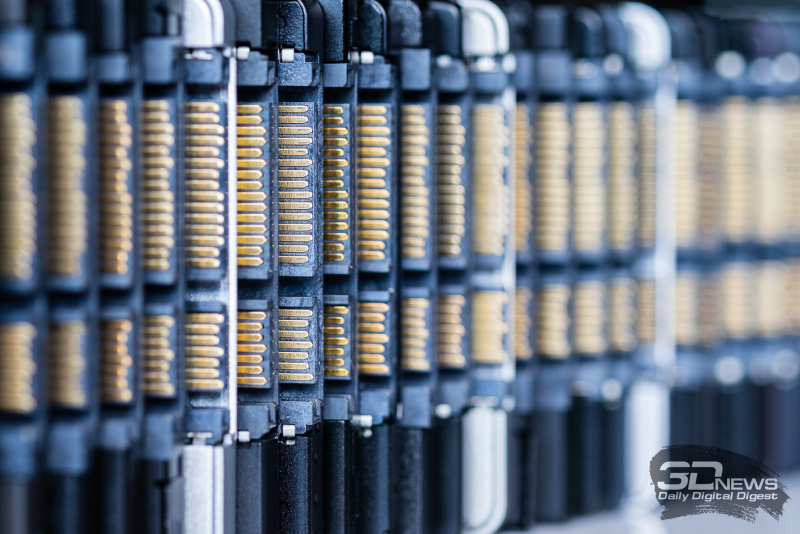
To formulate final recommendations as to which of the terabyte SATA SSDs are of the greatest interest, we have compiled a price-performance map, which combines the average SSD speed according to the test results and their average cost according to Yandex.Market data (for Moscow as of 31.05.21 .860). Prices are plotted on the ordinate on this map, and productivity is plotted on the abscissa. The dots correspond to different SATA SSD models, the shape of the marker indicates the presence of a DRAM buffer in the drive. Full-fledged SSDs are marked with round markers, and buffer-less ones with triangular markers. The blue color of the marker means QLC-memory, orange – TLC. It should also be added that the unique MLC-drive Samsung 20 PRO did not fit on the above card due to the high cost exceeding XNUMX thousand rubles.

The given illustration hardly needs any detailed comments. Therefore, we just have to give out a list of the most attractive models.
- From the point of view of the optimal ratio of price and performance, the greatest interest at the moment is Samsung 870 EVO… This is unlikely to be a special revelation for anyone – Samsung SATA drives have long won a brilliant reputation as models with very good performance and high reliability. But the new Samsung 870 EVO also has a rather attractive price, which looks quite democratic at the general level.
- It is impossible to ignore Seagate Barracuda 120 – a drive that at least slightly, but still surpasses the Samsung 870 EVO in terms of integral performance. However, there are two problems with it. First, for a meager advantage, you need to pay a significant premium. Secondly, it is very difficult to find it on sale.
- If the Samsung 870 EVO seems too expensive for you, it makes sense to pay attention to Samsung 870 QVO… It costs more than 1500 rubles cheaper, but at the same time it significantly outperforms all offers close to it in terms of performance. However, there is a nuance – this drive is based on QLC memory, so it is not designed for high loads during operation.
- An interesting option cheaper than the Samsung 870 EVO, but at the same time without any compromises in architecture, can be Crucial MX500… It is more expensive than the Samsung 870 QVO and does not surpass it in terms of average performance, however, it uses high-quality TLC 3D NAND, which you can not worry about premature wear during intensive use. At the same time, it should be noted that the old Samsung 500 EVO may be available in some places for a price comparable to the MX860, and it looks even more interesting than the Crucial drive in terms of the combination of consumer qualities. However, it is getting harder and harder to find it every day.
- There is frankly nothing to recommend to purchase drives with a bufferless design and QLC memory – there are a lot of well-founded claims to their performance and other consumer qualities. But if the choice of the right SATA SSD comes with the need for harsh savings, then the best option at the moment would be to buy Patriot burst elite or Seagate Barracuda Q1… These are almost the cheapest options among the terabyte SATA SSD, which at least does not fall into a stupor when it comes to servicing mixed or multi-threaded operations, as does the WD Green or Crucial BX500.
If you notice an error, select it with the mouse and press CTRL + ENTER.





